Each state in the U.S. has several official symbols, including a flag, bird, tree, and of course, flower. Do you know the official flower of your state? Browse through this state flowers list to learn more about your and other state flowers, and perhaps create a new, unique garden theme in your landscape.
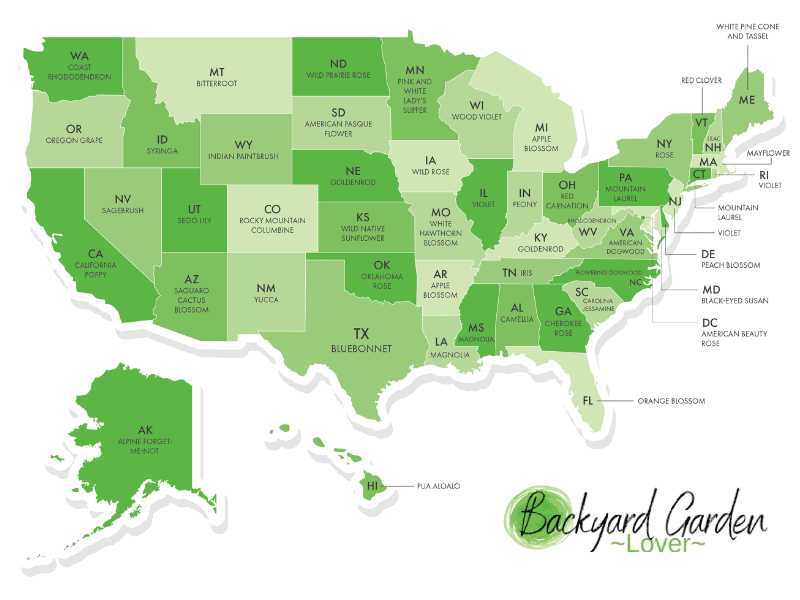
Although some official state flowers are native species, others are not native to the state they represent or even to this country. And Maine’s state flower isn’t a flower at all! Additionally, some states have chosen the same flower, so you may notice a few repetitions in this list.
State Flowers List
Alabama state flower – camellia (Camellia japonica)
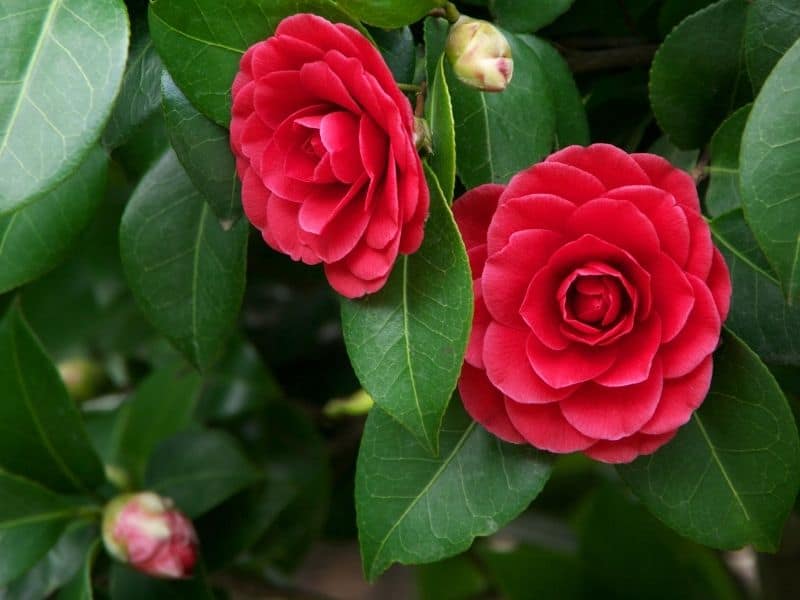
Camellia replaced goldenrod as the state flower of Alabama in 1959. This broadleaf evergreen shrub is native to parts of Asia and grows about eight to 20 feet tall and wide. Occasionally called “the rose of winter,” camellia blooms in spring and fall, as well as winter in milder climates. The many varieties range from single to formal double blossoms in pink, white, and crimson.
This low-maintenance shrub grows well with rhododendron and azalea. Camellia prefers partial shade and rich, acidic, well-draining soil. Once established, it will tolerate drought.
Alaska state flower – alpine forget-me-not (Myosotis alpestris)
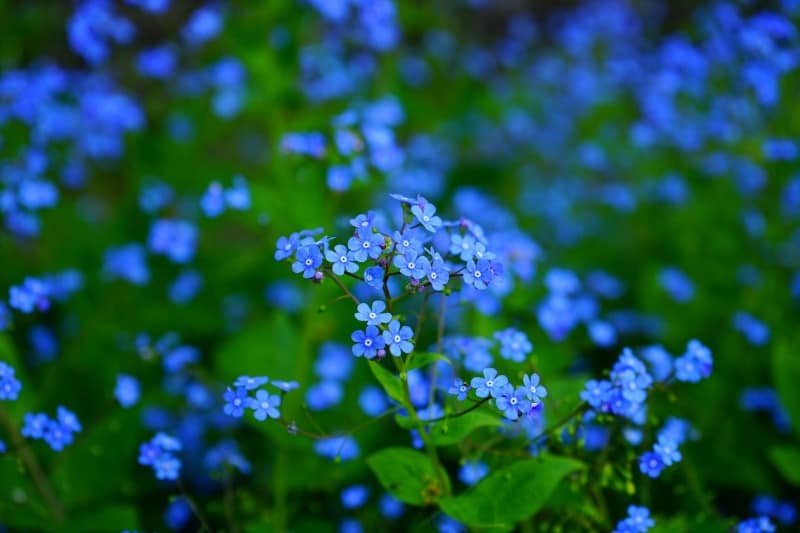
In 1917, Alaska declared the native alpine forget-me-not its official flower. This low-growing plant grows wild in open, rocky areas in the mountains and spreads readily in the garden under ideal conditions. Its clusters of tiny flowers bloom in midsummer, a cheerful display of blue petals surrounding yellow centers.
Forget-me-nots thrive in full sun in mild climates and afternoon shade where summers get hot. In the South, they are often grown as cool-season annuals, as the heat and humidity can kill them off. They should always receive consistent moisture.
Arizona state flower – saguaro cactus blossom (Carnegia gigantean)
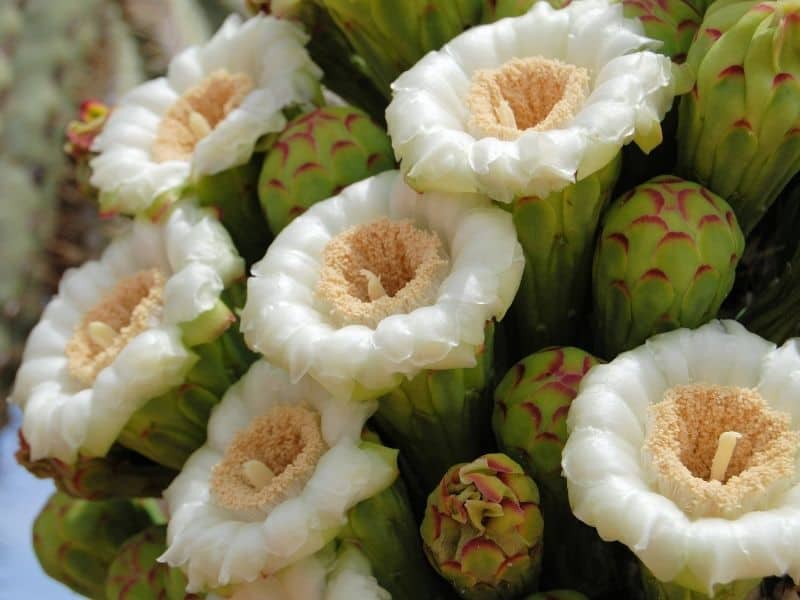
Designated as the Arizona state flower in 1931, the saguaro cactus blossom grows on the largest cactus in the U.S. This native of the Sonoran Desert can reach a height of 50 feet in its lifetime, which is up to 200 years.
The saguaro cactus also grows very slowly and might produce its first flower at 35 years old. Opening only at night, the creamy-white blossoms bloom in the spring and are pollinated by bats and moths, among other nocturnal creatures.
Saguaro cacti rarely transplant well and should never be dug up from the desert, which is illegal. If you purchase a property already containing a saguaro cactus, make sure it grows in well-draining grit and receives low levels of water.
Arkansas state flower – apple blossom (Malus domestica)
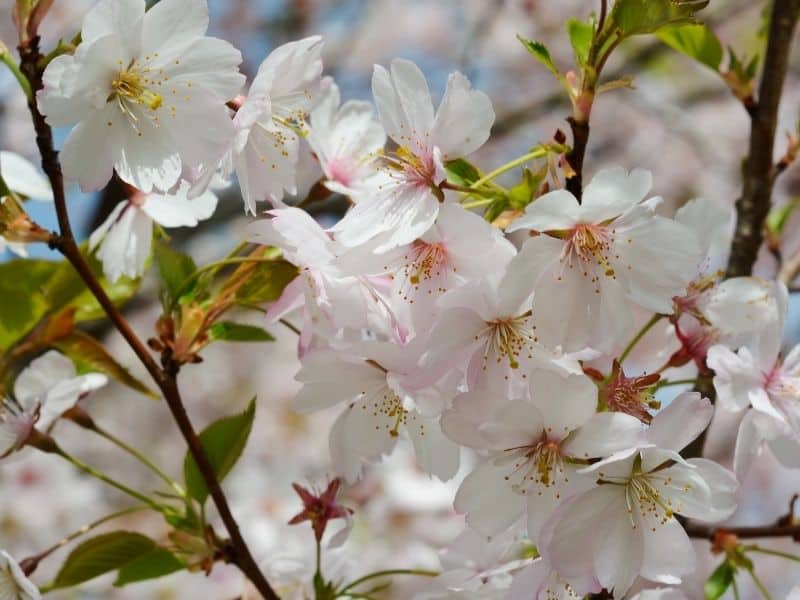
Once a major apple-producing state, Arkansas designated the apple blossom as its state flower in 1901. Apple trees range from tiny dwarf varieties to 20-foot trees, with numerous cultivars offering fruits with varying colors, flavors, and textures. This popular European fruit tree produces deep pink buds that open in mid-spring to reveal white petals faintly streaked with pink.
Although specific growing requirements vary by cultivar, most apple trees thrive in full sun and well-draining soil. Most varieties cross-pollinate, so it’s important to plant at least two apple trees in the same vicinity.
Got apple trees in your backyard? Here’s what to do with apples.
California state flower – California poppy (Eschscholzia californica)
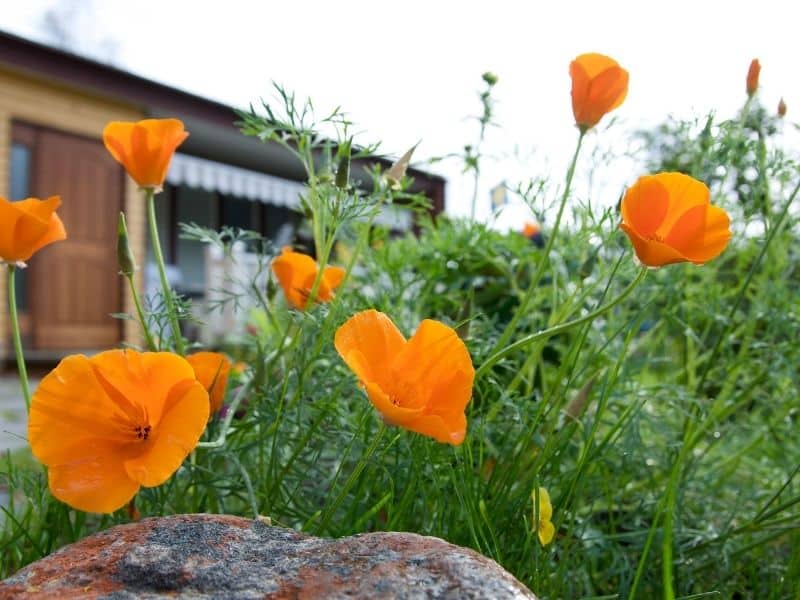
Also called flame flower and copa de oro (cup of gold), the California poppy was named California state flower in 1903, and April 6 has since been designated as California poppy day. The plant’s golden, cup-shaped flowers bloom above tufts of feathery foliage for a beautiful display of texture as well as color. Though technically a short-lived perennial, the California poppy is often grown as an annual.
Given its native habitat, the California poppy requires full sun and well-draining, preferably sandy or rocky, soil. It will not tolerate wet soil but will thrive with little to no added nutrients. In ideal conditions, California poppy will happily reseed.
Colorado state flower – Rocky Mountain columbine (Aquilegia caerulea)
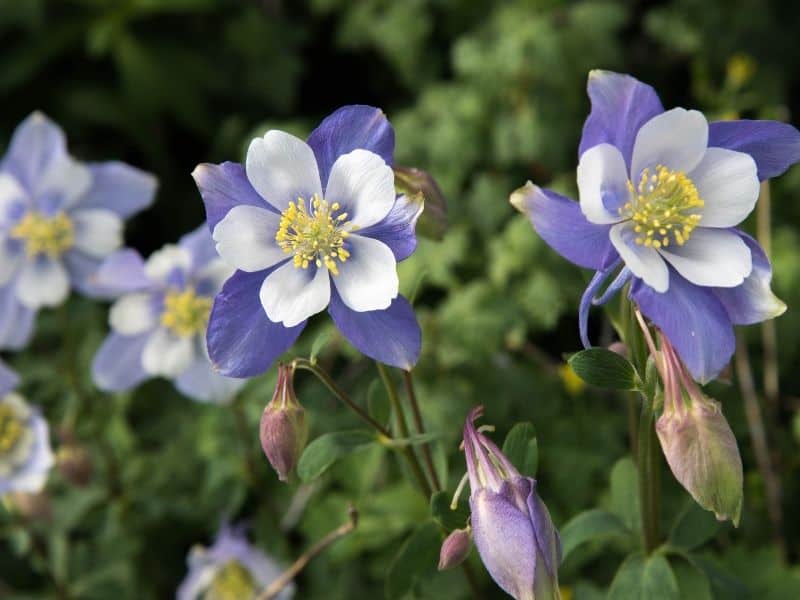
Rocky Mountain columbine became the state flower of Colorado in 1899 after a vote by the state’s schoolchildren. In 1915, Colorado also adopted “Where the Columbines Grow” as the state song. This unique wildflower features five blue sepals and spurs and five white petals around yellow stamens. With their sweet nectar, the claw-like spurs attract hummingbirds, bees, and butterflies.
Rocky Mountain columbine prefers rich, moist, well-draining soil and partial shade, though it also tolerates full sun and average soil.
Connecticut state flower – mountain laurel (Kalmia latifolia)
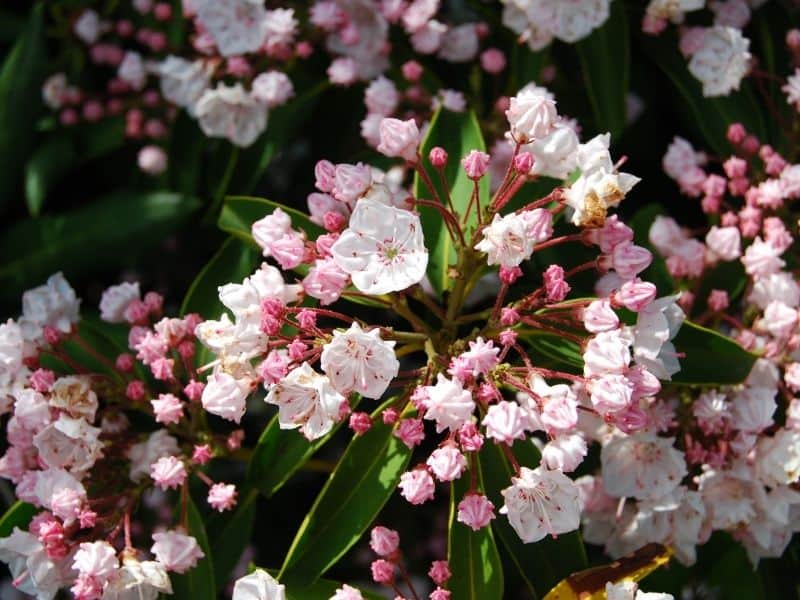
Connecticut named mountain laurel the state flower in 1907. An evergreen shrub native to eastern North America, mountain laurel blooms in the spring with fragrant clusters of pink to white blossoms. Its shiny, dark-green foliage provides beauty all year long. Depending on the cultivar, the size of mountain laurel ranges from eight to 20 feet tall and up to 12 feet wide.
Mountain laurel thrives in acidic, moist, well-draining soil rich in organic matter. It prefers partial shade but will tolerate full sun if provided with sufficient moisture.
Delaware state flower – peach blossom (Prunus persica)
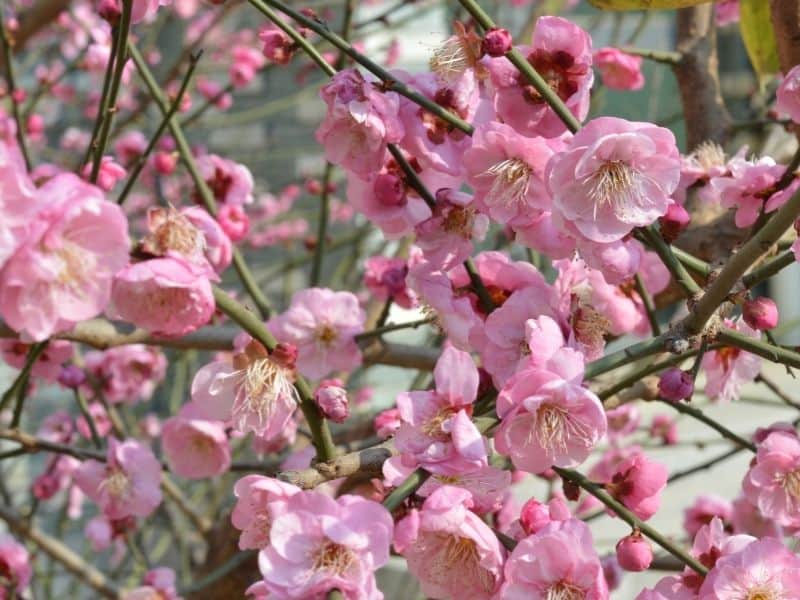
Because of its more than 800,000 peach trees and a reputation as “The Peach State,” Delaware chose the peach blossom as the state flower in 1895. Pink peach blossoms are as beautiful as the tree’s fruit is sweet, blooming in early spring on the previous year’s growth. Depending on the variety, the fruit ripens around midsummer to midfall.
Peach trees grow best in loose, fertile, well-draining soil in full sun. At least eight hours of sunlight each day is essential for fruit-set.
Have a peach tree in your backyard Here are 7 ways to preserve peaches.
District of Columbia official flower – American beauty rose (Rosa ‘American Beauty’)
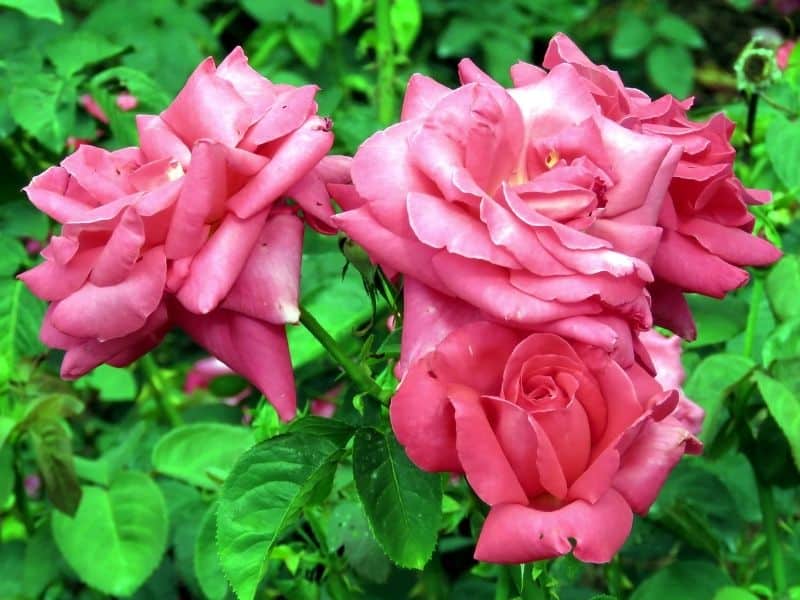
Although not technically a state, Washington, D.C. designated the American beauty rose as its official state flower in 1925. The large, deep pink blossoms give off a strong fragrance, making them perfect for planting along walkways or next to benches. This hybrid shrub grows to about four to six feet tall and is hardy to USDA zone 5.
Roses often prefer full sun and well-draining soil, and they appreciate regular watering and feeding. Sufficient airflow will help prevent common fungal diseases.
Here are rose pictures you’ll love!
Florida state flower – orange blossom (Citrus sinensis)
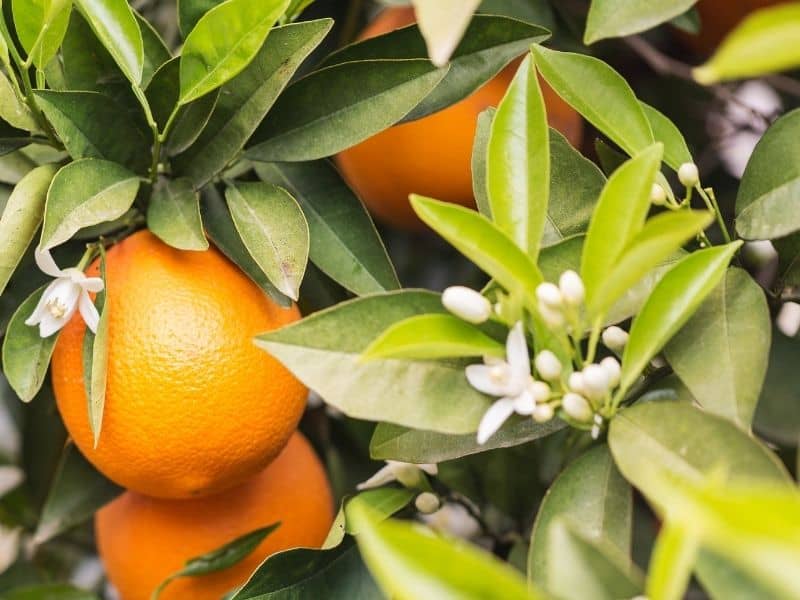
The orange tree provides not only Florida’s state flower – the orange blossom, designated in 1909 – but also its state fruit and beverage. When they bloom, the white, five-petaled flowers attract bees and perfume the landscape. Planting a mixture of early, mid, and late-season varieties of orange trees will allow you to harvest fresh oranges from November through June.
A warm-climate evergreen, the orange tree grows in zones 8-11. It thrives in well-draining soil in full sun, though it will tolerate some light shade.
Georgia state flower – Cherokee rose (Rosa laevigata)
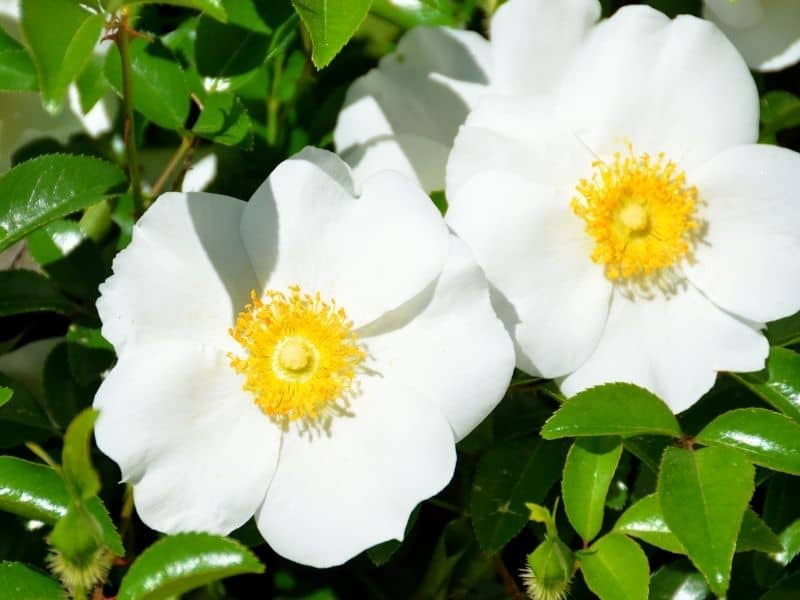
In 1916, Georgia named the Cherokee rose as the state flower. Although native to parts of Asia, this climbing rose has naturalized in the southeastern U.S. and is even part of a Cherokee legend about the Trail of Tears. It is, however, considered invasive in several states, so check with your local extension office before planting. Cherokee rose makes up for its excessive thorns with fragrant, white, single blooms with yellow centers.
This semi-evergreen to evergreen rose thrives in full sun but tolerates some shade as well as poor soil and drought.
Hawaii state flower – Pua Aloalo (Hibiscus brackenridgei)
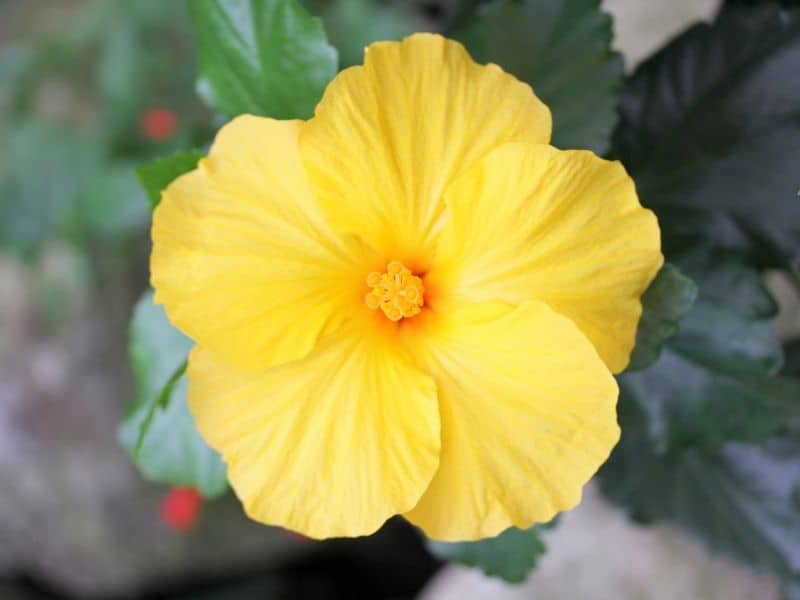
Designated as the Hawaii state flower in 1998, Pua Aloalo, also called yellow hibiscus or Ma’o Hau Hele, grows wild on all of the main islands. This endangered native plant grows anywhere from three to 15 feet tall and features large, yellow blossoms with crepey, egg-shaped petals around a prominent staminal column.
Pua Aloalo’s natural habitat is dry forests and lower-elevation shrublands. Although it grows quickly, it may not live more than a couple of years, so make sure to take cuttings or collect seeds.
Idaho state flower – syringa (Philadelphus lewisii)
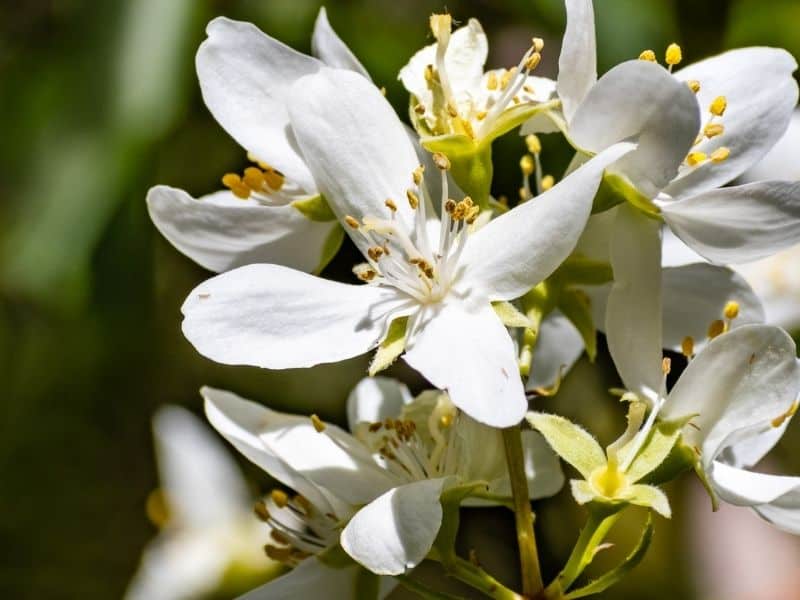
Also called mock orange, syringa became the Idaho state flower in 1931. This woody shrub produces masses of fragrant, white, four-petaled flowers in early summer. After the blooms fade, four sepals cup each green seed capsule, further decorating the shrub until the capsule releases the seeds in late summer.
Once established, syringa requires very little care. This western U.S. native prefers full sun and evenly moist, well-draining soil, ideally with plenty of loam and organic matter.
Illinois state flower – violet (Viola sp.)
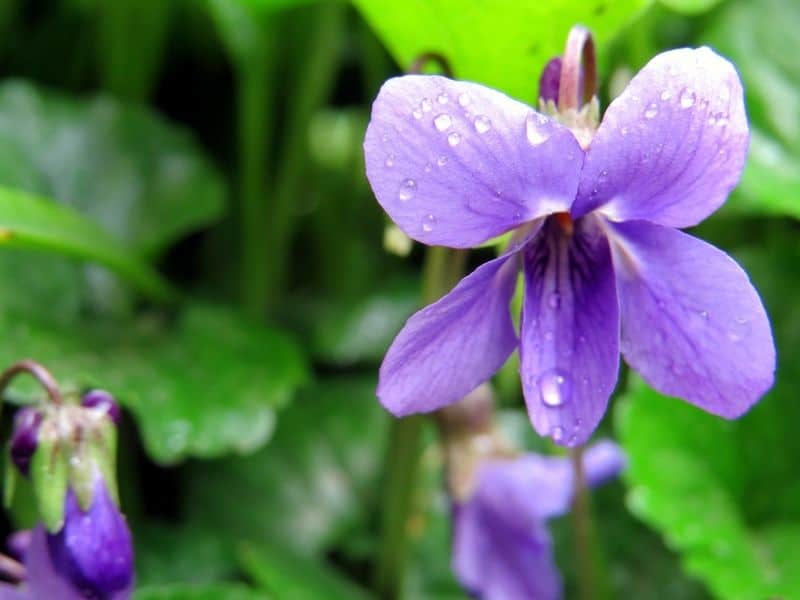
In 1908 schoolchildren selected the violet as the Illinois state flower, making Illinois the first of four states to choose this flower. Violets can be found growing wild in prairies, woodlands, and wetlands of North America. Their cheerful spring blossoms give the impression of faces and come in a surprising variety of colors.
Most species of violet prefer rich, organic soil with consistent moisture and full sun to partial shade, depending on the variety.
Indiana state flower – peony (Paeonia sp.)
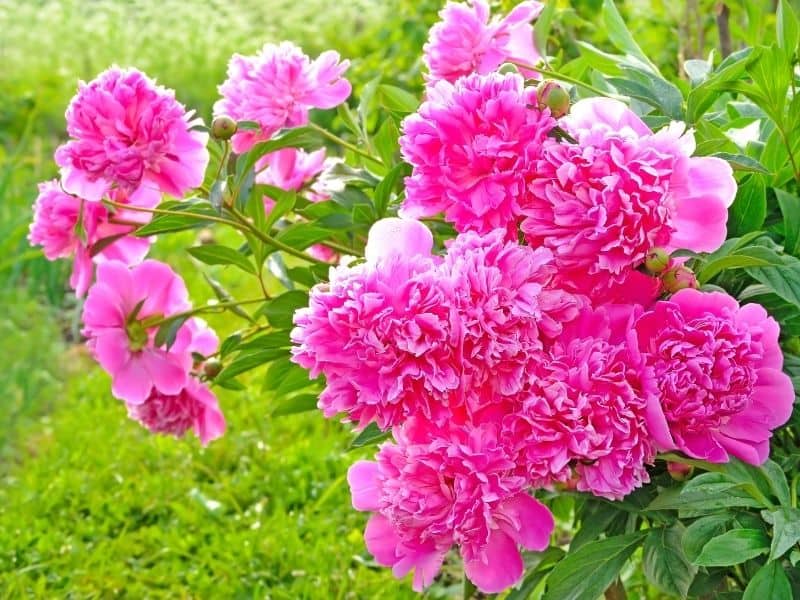
In 1957, the peony replaced the zinnia as Indiana’s state flower. The asparagus-like red shoots of herbaceous peonies appear in early spring, unfurling to reveal green leaves. Their large, often scented blossoms bloom in late spring and early summer in shades of red, pink, orange, yellow, or white.
Peonies grow best in well-draining soil and full sun, though they will tolerate partial shade, especially when provided with sufficient airflow to prevent powdery mildew.
Iowa state flower – wild rose (Rosa pratincola)
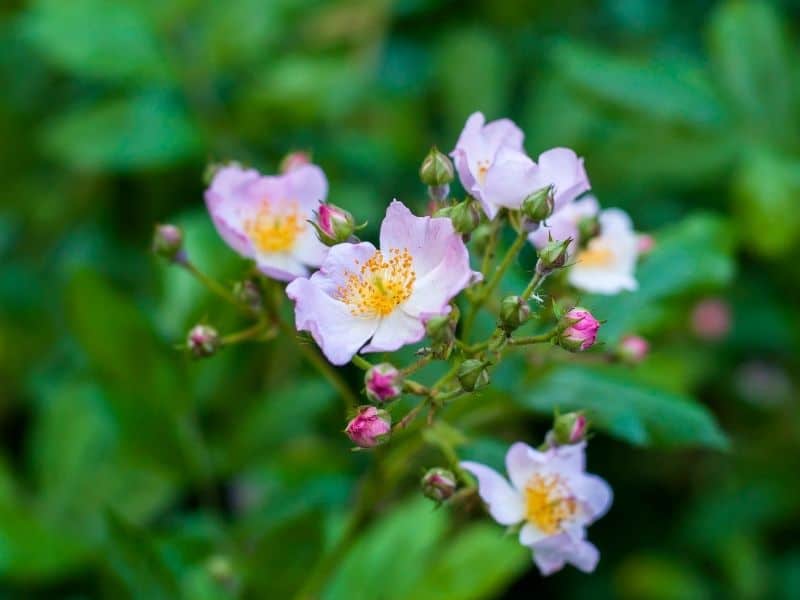
The wild rose was designated the state flower of Iowa in 1897 because it decorated the silver service presented to the USS Iowa battleship that year. While the state did not specify a particular species, the wild prairie rose (R. pratincola, aka R. arkansana) is cited most often. In Iowa, wild roses bloom June through late summer, with pink petals surrounding yellow stamens.
The low-maintenance wild prairie rose is extremely hardy and tolerates drought well. All it needs are well-draining soil and at least six to eight hours of direct sunlight each day.
Kansas state flower – wild native sunflower (Helianthus annuus)
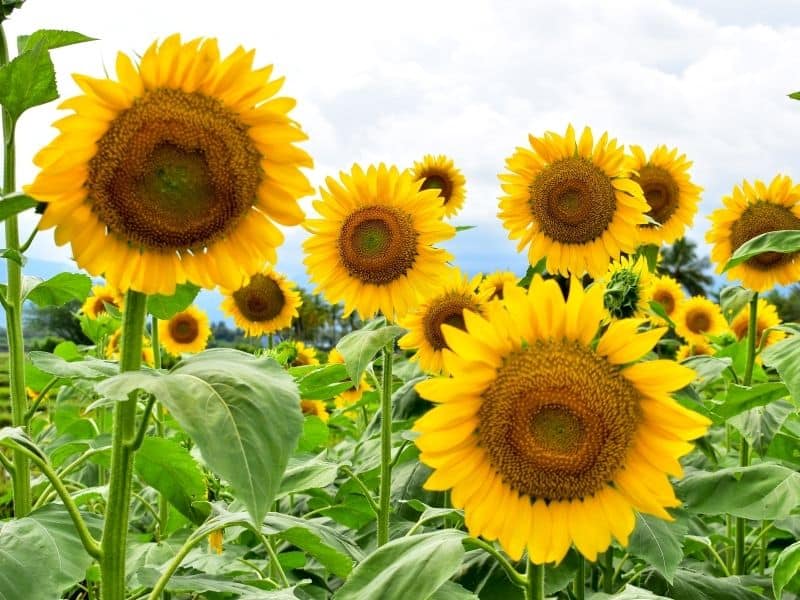
Known as “The Sunflower State,” Kansas designated the wild native sunflower as its state flower in 1903. Although a bit smaller than what we might expect at three to four inches across, the blossoms of this North American wildflower are no less bright and cheerful. The sunny flowers perch on two- to six-foot-tall stalks and attract butterflies and hummingbirds throughout their summer bloom time.
Sunflowers require full sun for strong stems and prefer moist, well-draining soil.
Kentucky state flower – goldenrod (Solidago sp.)
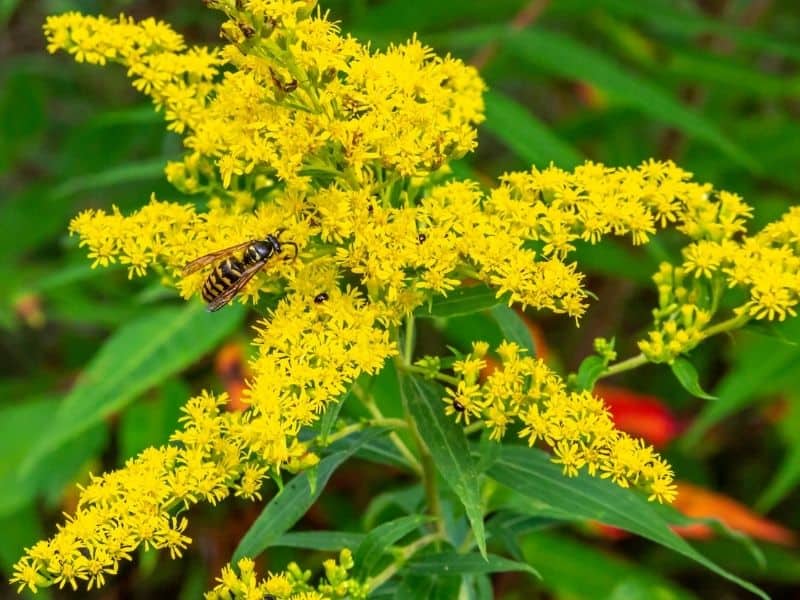
Kentucky designated goldenrod as its state flower in 1926. With about 30 varieties of goldenrod growing wild throughout the state, it seems a fitting choice. Its beautiful spikes of tiny yellow flowers tower three to eight feet above the ground and attract butterflies, bees, and other pollinators.
This underappreciated wildflower is often blamed for seasonal allergies, though since goldenrod relies on insects, not wind, for pollination, it’s not actually the cause (look instead to ragweed).
Although growing requirements vary by species, most goldenrod thrives in full sun and moist, well-draining soil. Once established, it will tolerate drought and may spread.
Louisiana state flower – magnolia (Magnolia grandiflora)
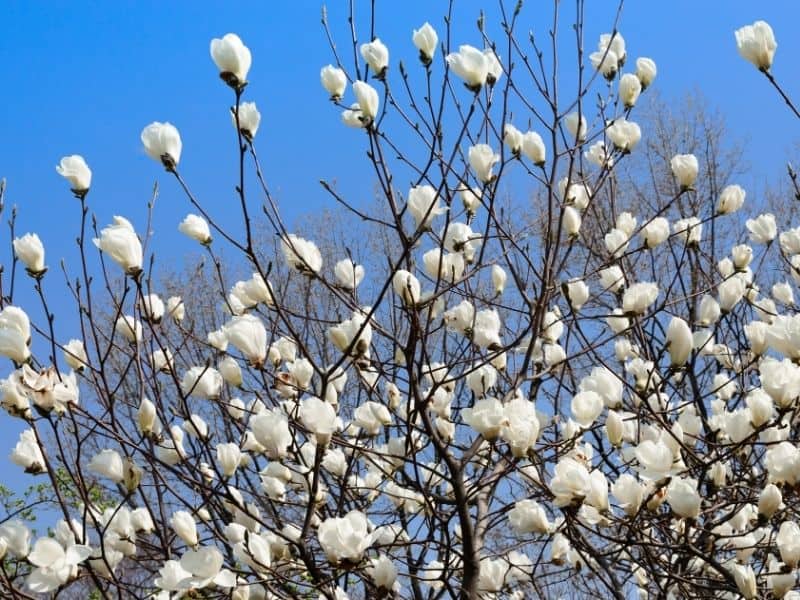
In 1900, Louisiana named the magnolia its official state flower. The southern magnolia, a majestic North American native, can grow 60 feet tall. It produces large, white, fragrant flowers in early spring and keeps its leathery, deep green leaves with fuzzy undersides all year for perpetual beauty.
Magnolias are easy to care for, requiring only well-draining soil and full sun. Once established, the trees are drought tolerant.
Maine state flower – white pine cone and tassel (Pinus strobes)
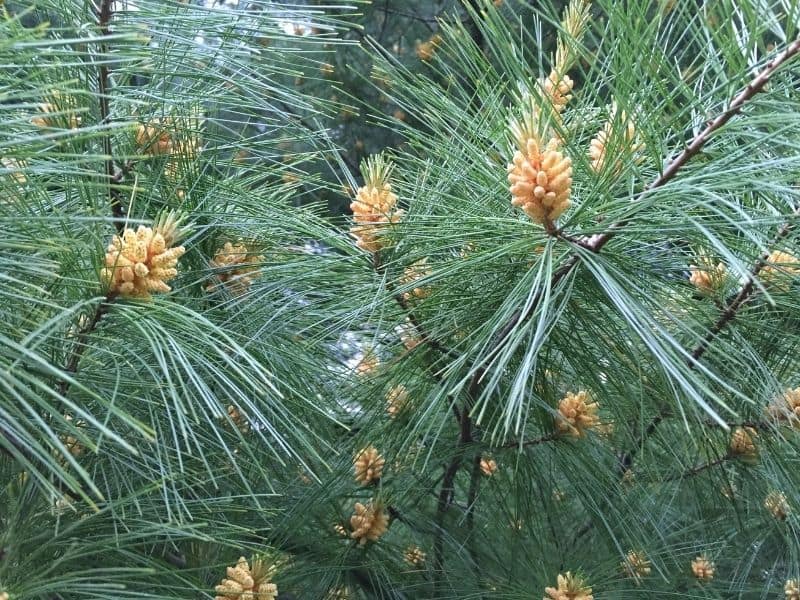
Although technically not a flower, the white pine cone and tassel were selected as the Maine state flower in 1895. Botanically, white pines are gymnosperms – literally, “naked seed” – meaning the seeds are not enclosed in an ovary and the tree doesn’t produce flowers. The tall white pine is also Maine’s state tree and features long, soft needles that add a delicate texture to the state’s landscape.
Pine trees grow best in well-draining soil with medium moisture and full sun.
Maryland state flower – black-eyed Susan (Rudbeckia hirta)
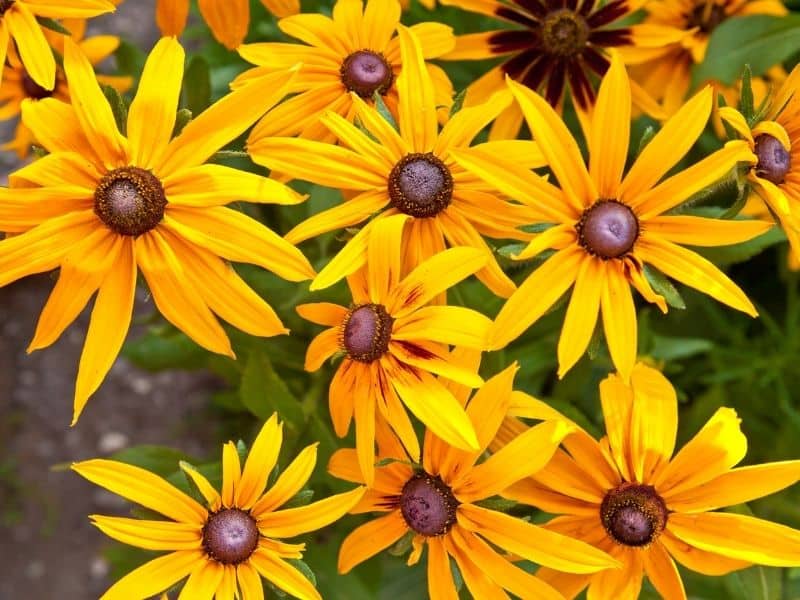
In 1918, Maryland designated the black-eyed Susan as its state flower. This daisy-like native of North American prairies grows up to three feet tall and blooms from about May through August. A mass planting provides a sea of beautiful golden petals and dark centers held above mounds of lovely green foliage.
Being wildflowers, black-eyed Susans require little care and tolerate a range of soils, though they grow best in full sun.
Massachusetts state flower – mayflower (Epigaea repens)
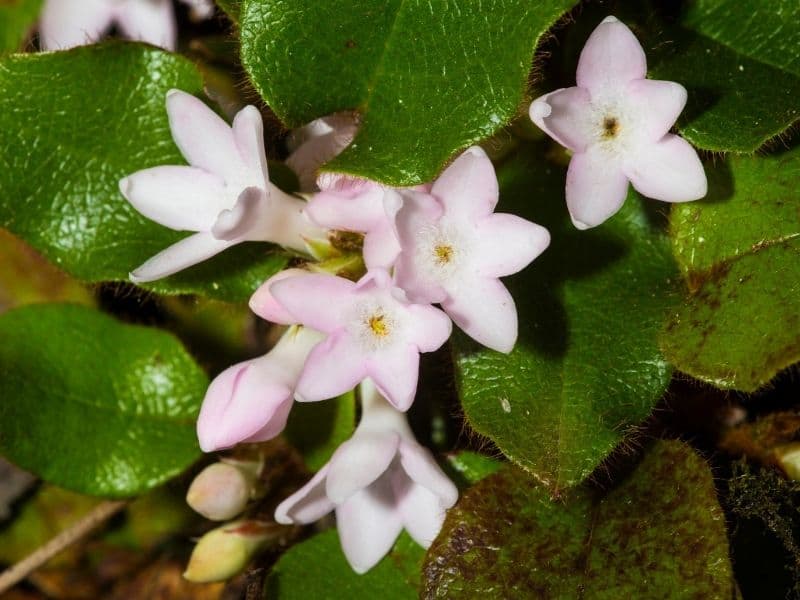
It should come as no surprise that Massachusetts chose the mayflower as its state flower in 1918. Also called trailing arbutus or ground laurel, this endangered North American native grows low to the ground in thick mats and blooms in early spring with small, white, or pink blossoms.
Mayapple grows wild in the woods, especially under pine trees, and thus prefers a shady spot with sandy or rocky soil.
Michigan state flower – apple blossom (Pyrus coronaria)
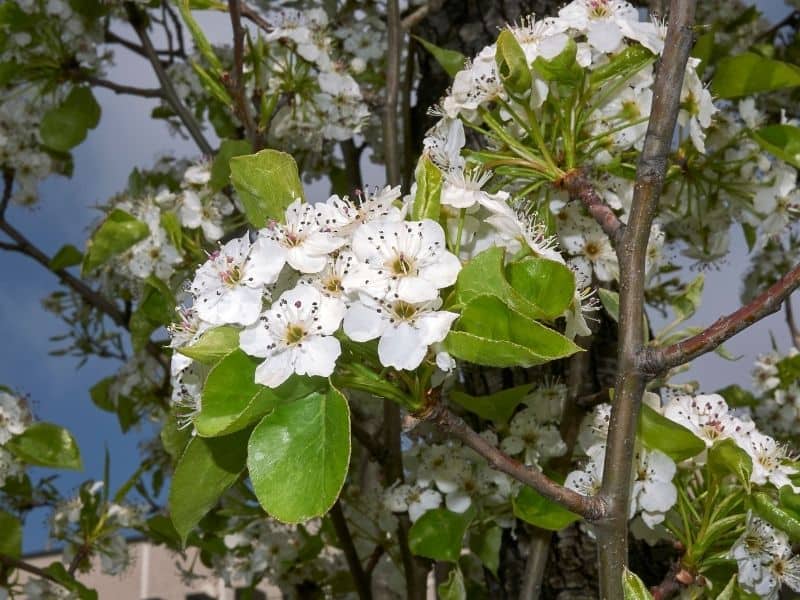
Like Arkansas, Michigan chose the apple blossom as its state flower, though four years earlier in 1897. The resolution cites native Malus coronaria, or the American crabapple, as “one of the most fragrant and beautiful species of apple.”
Although crabapples are most often planted for their ornamental and wildlife value, their fruit makes delicious preserves and desserts. They grow 15-25 feet tall and produce fragrant pink flowers in early spring.
Crabapples thrive in moist, well-draining soil and full sun, though they will tolerate heavy soil and partial shade.
Minnesota state flower – pink and white lady’s slipper (Cypripedium reginae)
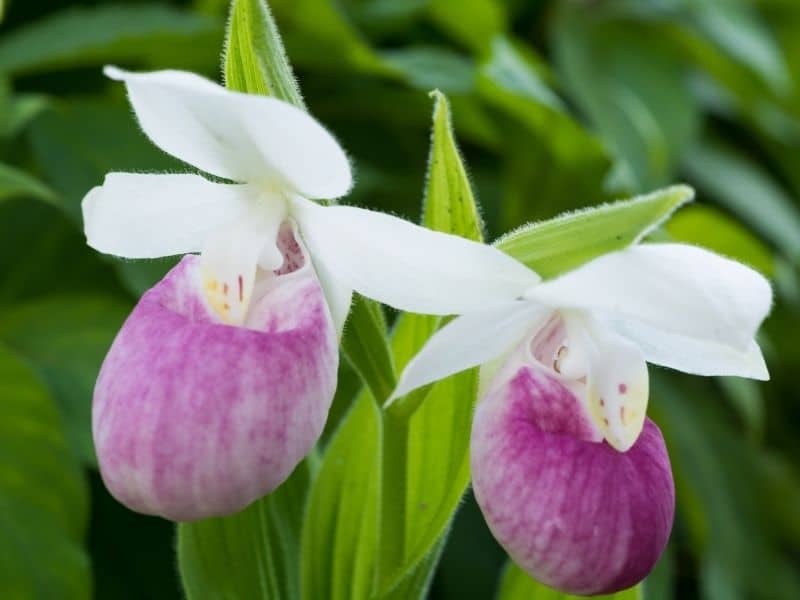
Also called showy lady’s slipper, pink and white lady’s slipper was selected as Minnesota’s state flower in 1902. This long-lived native wildflower often waits as long as 16 years to produce its first flower. An orchid, pink and white lady’s slipper produces three white petals above a pink-streaked pouch, or slipper, in June and July.
Pink lady’s slipper thrives in moist, shady areas and can be found growing in swamps, wet meadows and prairies, spruce and tamarack bogs, and damp woods.
Mississippi state flower – magnolia (Magnolia grandiflora)
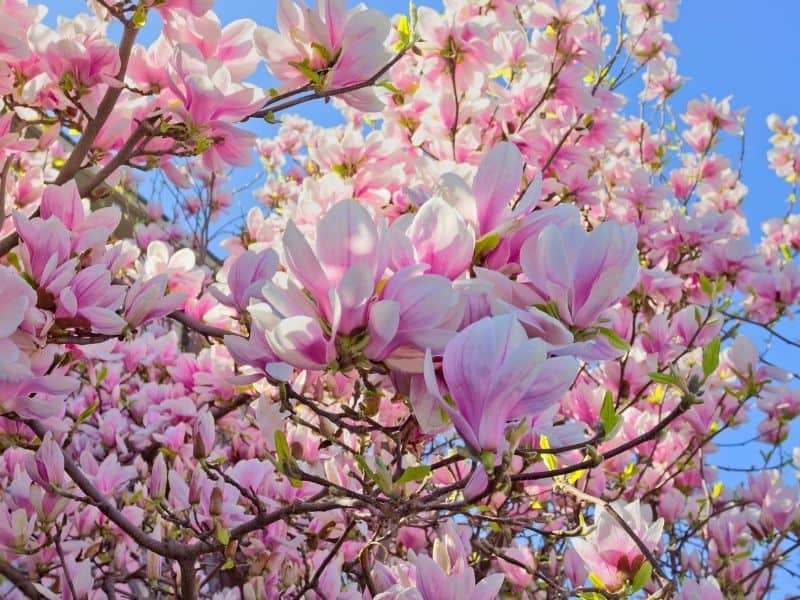
In 1900, the same year Louisiana designated it, Mississippi schoolchildren voted for magnolia as the state flower, and in 1952 the Legislature made it official. Called “The Magnolia State,” Mississippi also selected magnolia as its state tree. A magnificent native flowering tree, the southern magnolia blooms in early spring with fragrant, white, or pink blossoms against its glossy, leathery evergreen leaves.
This low-maintenance plant needs only full sun and well-draining soil and becomes drought tolerant once established.
Missouri state flower – white hawthorn blossom (Crataegus sp.)
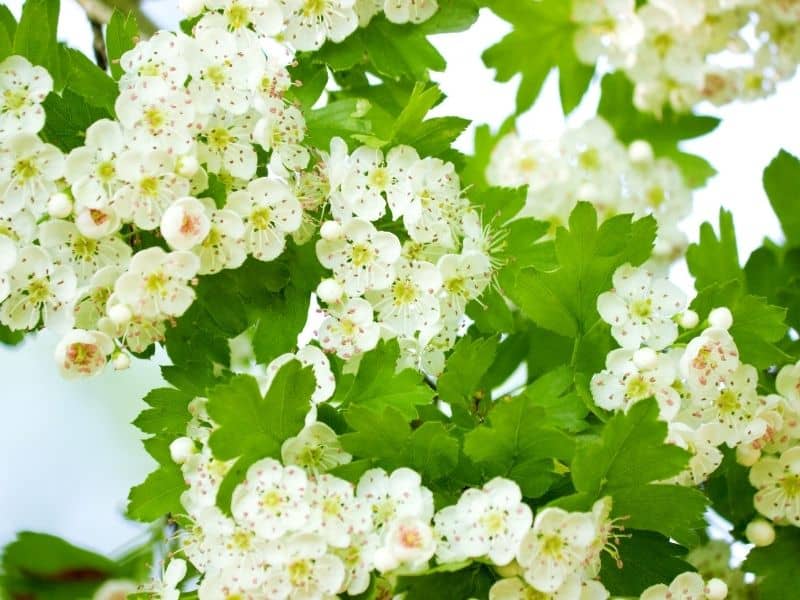
Missouri named white hawthorn blossom its state flower in 1923. More than 75 species of this native tree grow in Missouri, especially in the Ozarks. In the spring, clouds of white or pinkish flowers bloom on the showy tree. It also produces attractive fall colors and bright red fruits like rosehips that provide winter interest, attracts wildlife, and can be used in jams.
Hawthorn thrives in average, well-draining soil and full sun. Being a native tree, it requires little care once established.
Montana state flower – bitterroot (Lewisia rediviva)
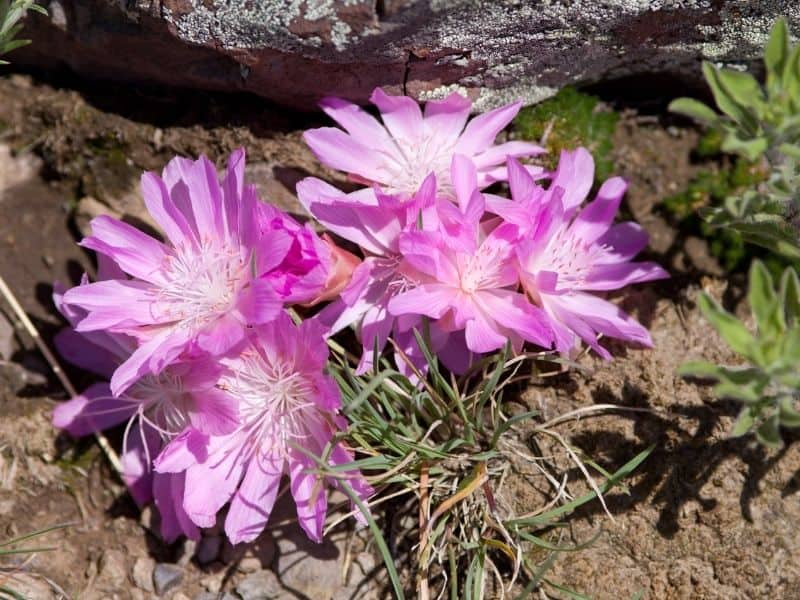
Bitterroot was chosen as the Montana state flower in 1895. This native plant grows in the foothills and sagebrush plains of Montana during the spring and summer and is the namesake of the Bitterroot Mountains, River, and Valley. Its beautiful purplish-pink blossom caught the attention of Lewis and Clark, and the Flathead, Shoshone, and other people often ate the bitter roots.
A hardy little succulent, bitterroot grows well in sandy or rocky conditions under full sun. It does not like too much water or nutrients.
Nebraska state flower – goldenrod (Solidago gigantea)
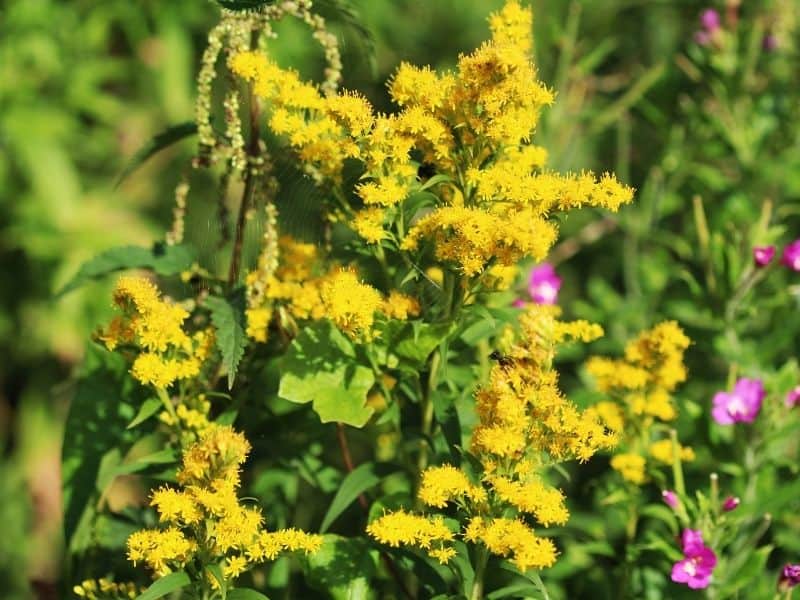
Decades before Kentucky chose the same state flower, Nebraska designated goldenrod as its official flower, in 1895. This common wildflower grows throughout North America, decorating meadows, roadsides, and transitional areas with its branching clusters of bright yellow florets from late summer into fall.
Giant goldenrod, the species specified by the legislature, prefers average to moist soil in a sunny location.
Nevada state flower – sagebrush (Artemisia tridentata)
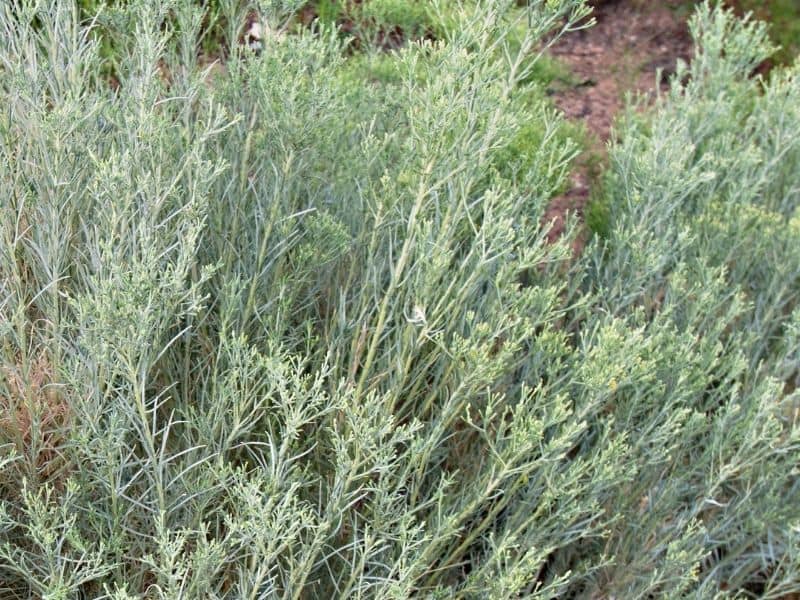
In 1917, Nevada adopted sagebrush as its official state flower. Known for its fragrant, silvery-green foliage, this native North American desert shrub can grow from three to 12 feet tall and about as wide. Its unassuming yellow flowers bloom in clusters at the tips of its evergreen branches in late summer.
An extremely hardy plant, sagebrush thrives in dry, rocky soil and full sun. It requires little to no irrigation once established and tolerates drought very well.
New Hampshire state flower – lilac (Syringa vulgaris)
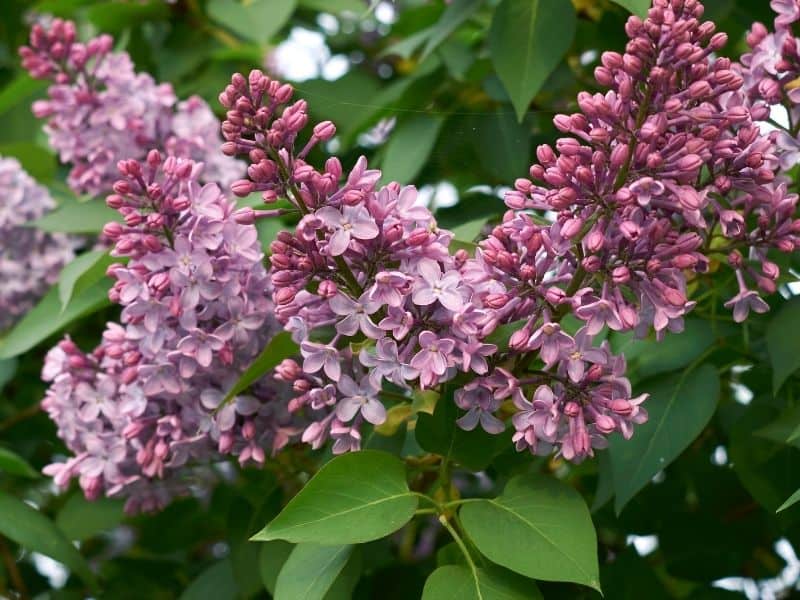
Lilac was selected as the state flower of New Hampshire in 1919. This deciduous European shrub can grow as large as 12 feet tall and 10 feet wide. Its strongly scented purple flower clusters bloom in the spring or summer, contrasting beautifully with its green foliage and grayish bark.
A hardy plant, lilac prefers well-draining, evenly moist soil in a sunny location, though it will tolerate partial shade as well as drought.
New Jersey state flower – violet (Viola sororia)
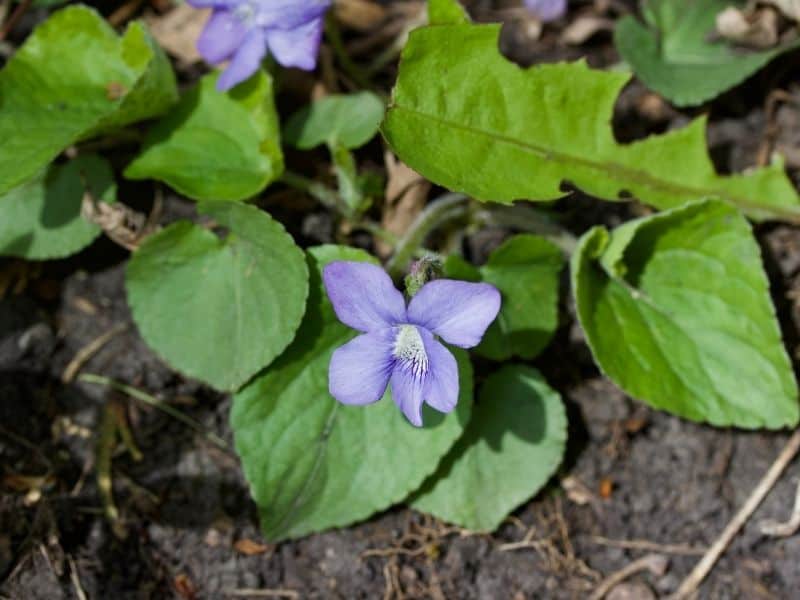
Shortly after Illinois adopted the violet as its state flower, New Jersey followed suit, in 1913. This lovely little North American wildflower provides beauty as well as wildlife value and is even used for culinary and medicinal purposes. The common blue violet (V. sororia), also known by many other names, blooms in shades of blue or purple in spring throughout the state and eastern North America.
Common blue violet thrives in humus-rich, well-draining soil with medium moisture and partial shade, though it will tolerate full sun with sufficient moisture.
New Mexico state flower – yucca (Yucca sp.)
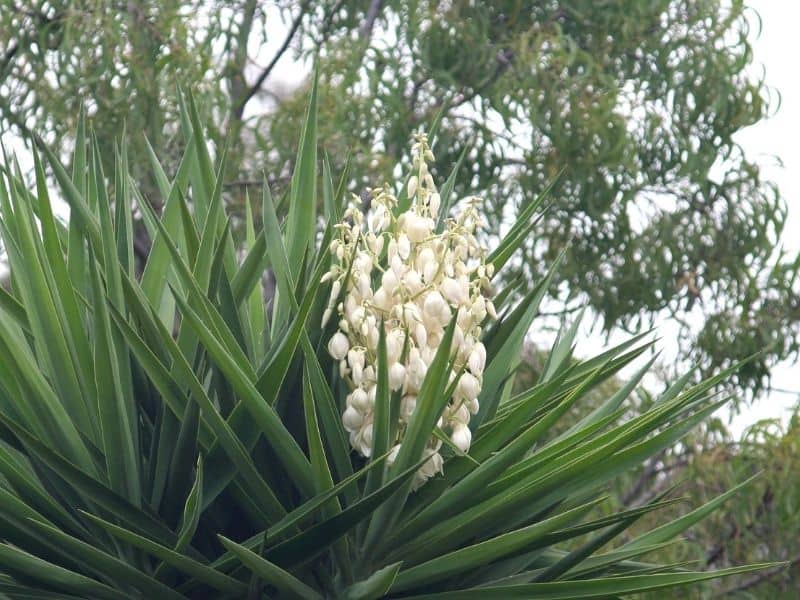
New Mexico chose the yucca blossom as its state flower in 1927 after a vote by schoolchildren and a recommendation by the New Mexico Federation of Women’s Clubs. Seven native yucca species grow abundantly throughout the state’s plains and deserts. While the unique, spiky leaves provide year-round beauty, each plant puts up a tall stalk of white or sometimes pink downward-facing blossoms in summer or fall.
Yucca requires dry, well-draining soil and full sun, making it an excellent addition to rock gardens or xeriscapes.
New York state flower – rose (Rosa sp.)
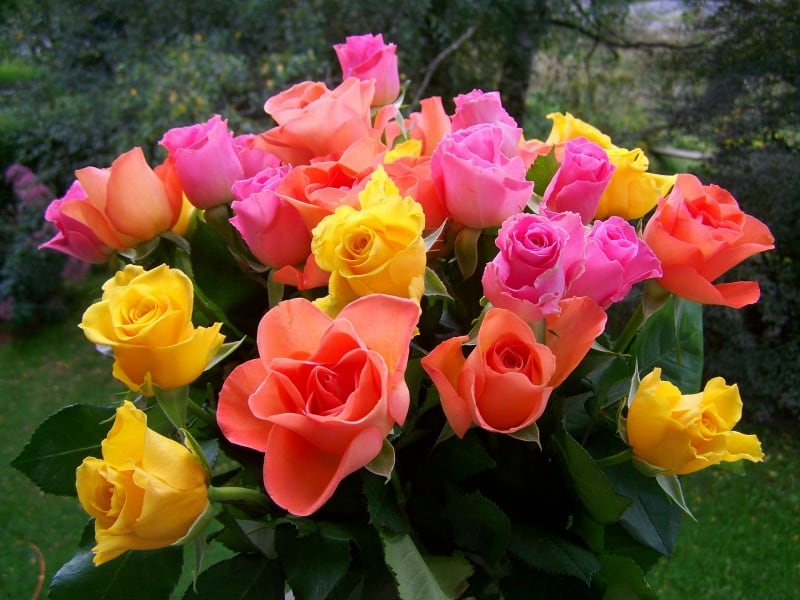
When New York designated the rose as its official state flower in 1955, it did not specify a particular species. In fact, the legislation states, “The rose shall be the official flower of the state in any color or combination of colors common to it.” With about 4,000 species of rose in existence today, there are many colors, as well as shapes and growth habits, to choose from!
Specific growing requirements will vary by cultivar, but most roses grow best in well-draining soil in a sunny location.
North Carolina state flower – flowering dogwood (Cornus florida)
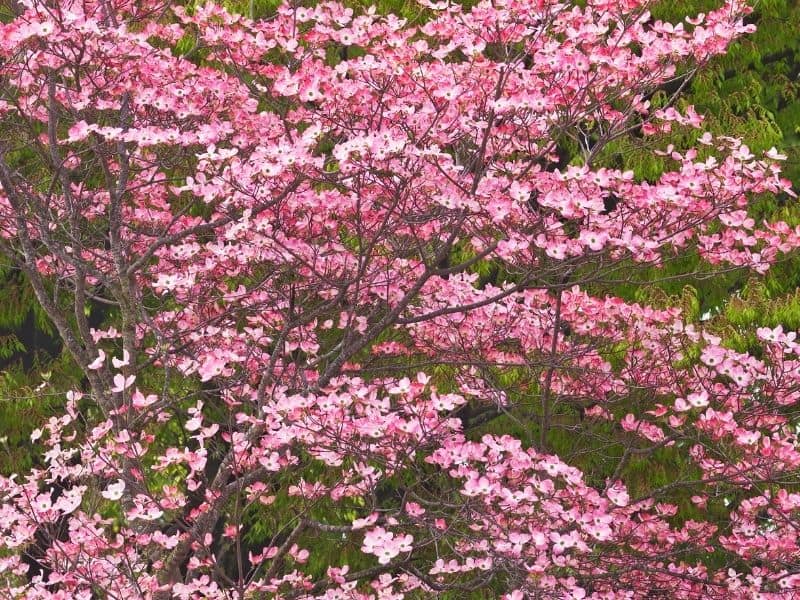
In 1941, North Carolina adopted the flowering dogwood as its state flower. One of the most common trees in the state, it can be found growing almost everywhere, from the coast to the mountains. This small native tree typically grows to about 20 feet tall and produces a showy display of four-petaled flowers in shades of white to pink in spring.
An understory tree, flowering dogwood prefers partial shade and slightly acidic, well-draining soil with plenty of organic matter and consistent moisture.
North Dakota state flower – wild prairie rose (Rosa arkansana)
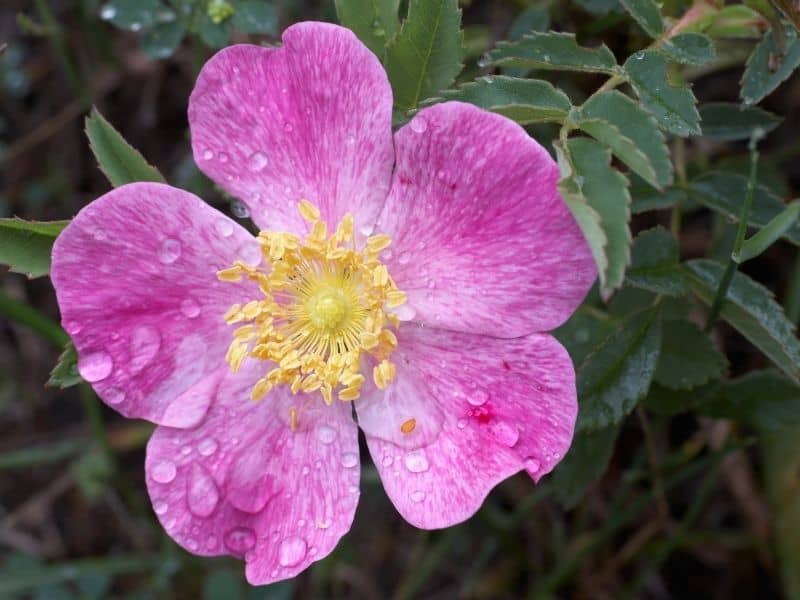
Wild prairie rose was chosen as the North Dakota state flower in 1907. This native rose grows wild in meadows, pastures, and roadsides throughout the state and spreads readily through both runners and seeds. In late spring through summer, wild rosebuds open to reveal five pink petals surrounding a cluster of bright yellow stamens.
Wild prairie rose thrives in well-draining soil and a sunny location. A hardy plant, it requires little care and tolerates drought.
Ohio state flower – red carnation (Dianthus caryophyllus)
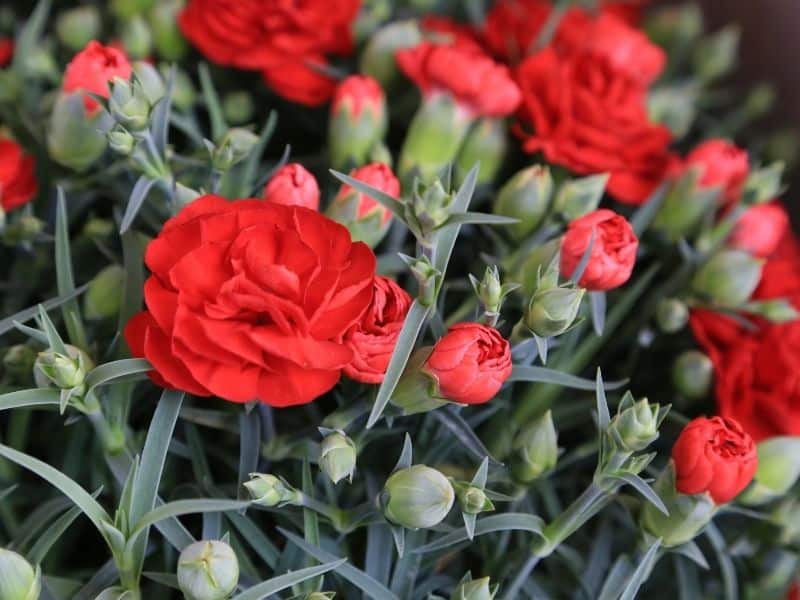
Ohio chose the red carnation as its state flower in 1904 in memory of President McKinley, who was assassinated in 1901 and had liked to wear red carnations on his lapel. In midsummer, carnations produce loosely tufted blossoms that give off a lovely fragrance. Although Ohio specifically chose the red carnation as its floral symbol, other colors include pink, white, yellow, and purple.
Carnations thrive in moist, gritty, well-draining soil with plenty of organic matter. They prefer full sun but will not tolerate extreme heat.
Oklahoma state flower – Oklahoma rose (Rosa ‘Oklahoma’)
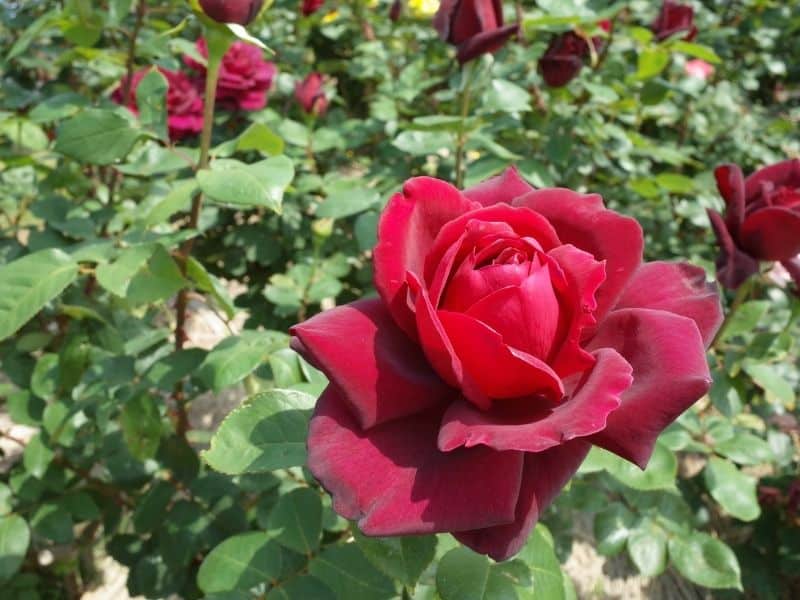
In 2004, Oklahoma designated the Oklahoma rose as its state flower. Although this seems recent, mistletoe was actually adopted in 1893, 14 years before Oklahoma became a state, and remains the state floral emblem today (as opposed to the state flower – they also have a state wildflower). A hybrid tea rose, Oklahoma rose features fragrant, dark red double flowers.
Hybrid tea roses grow best with full sun, well-draining soil, and good airflow.
Oregon state flower – Oregon grape (Mahonia aquifolium)
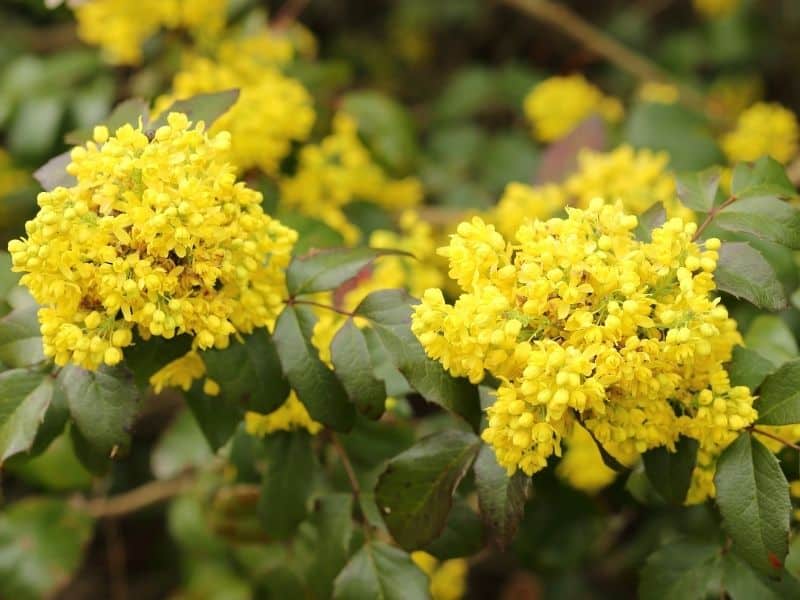
Oregon grape was chosen as the Oregon state flower in 1899. This evergreen shrub is native to the Pacific coast and a few areas east of the Cascades. It blooms in early summer with clusters of small yellow flowers, which give way to dark blue berries in the fall. Dark green, waxy leaves resembling holy leaves provide beauty in every season.
A woodland plant, the Oregon grape appreciates partial to full shade and neutral to acidic, evenly moist, well-draining soil.
Pennsylvania state flower – mountain laurel (Kalmia latifolia)
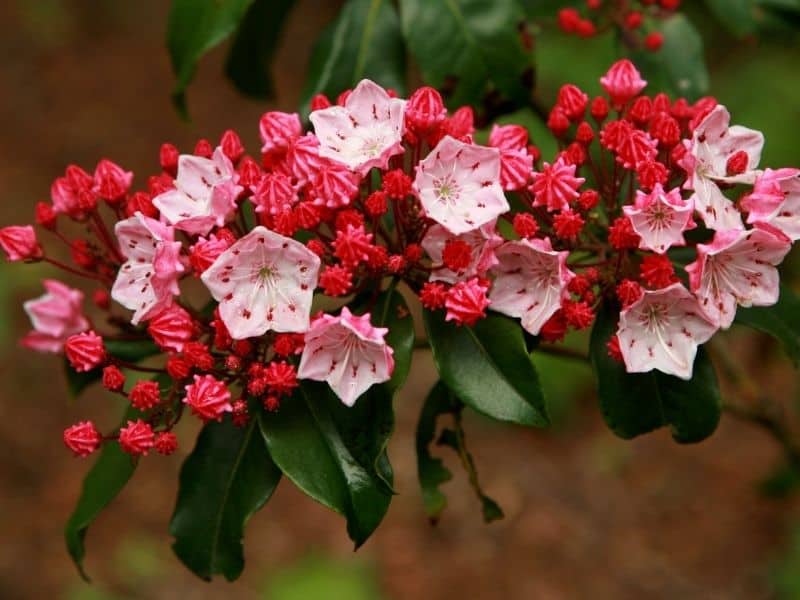
More than 20 years after Connecticut chose the same flower, Pennsylvania adopted mountain laurel as its official state flower. Native to the eastern U.S., mountain laurel produces fragrant, star-shaped, cupped blossoms in shades of pink and white in spring.
Mountain laurel grows best in partial shade but will tolerate more sun with sufficient moisture. It also appreciates moist, acidic well-draining soil with plenty of organic matter.
Rhode Island state flower – violet (Viola sororia)
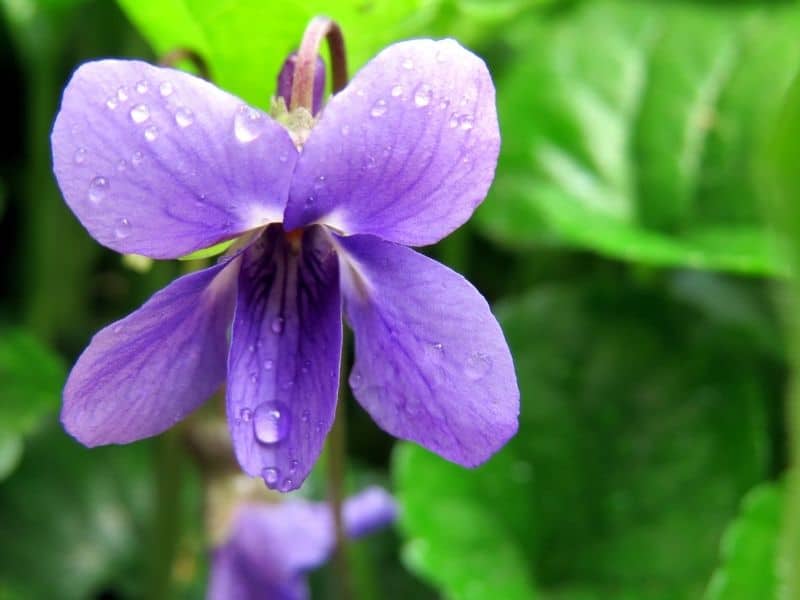
Although schoolchildren elected the violet as Rhode Island’s state flower in 1897, it was not officially designated until 1968, making Rhode Island the last state to select an official flower. It is also one of four states to choose the violet. The common blue violet grows wild throughout the eastern U.S. and blooms in the spring with blue or purple blossoms.
Violets prefer moderately moist, humus-rich, well-draining soil in partial shade.
South Carolina state flower – Carolina jessamine (Gelsemium sempervirens)
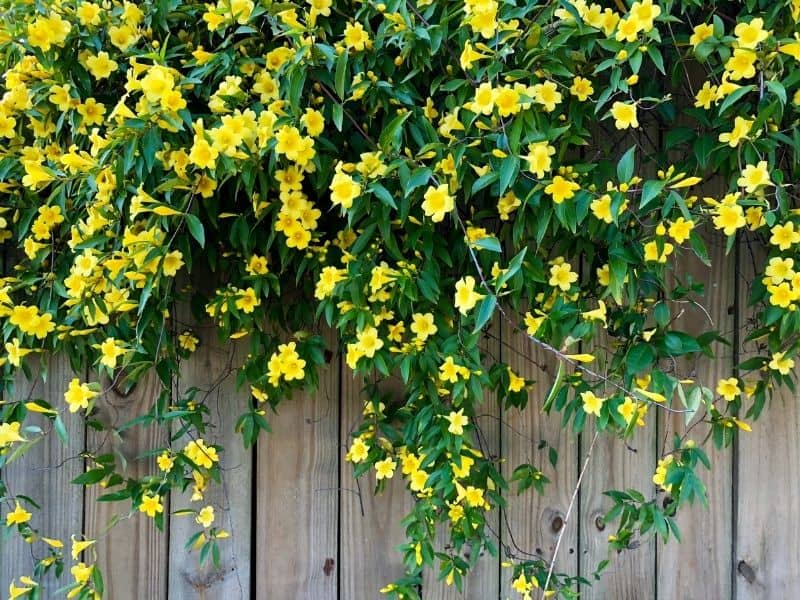
Also called yellow jessamine, Carolina jessamine was selected as the South Carolina state flower in 1924. This beautiful native vine can grow up to 20 feet long when left unpruned. From about February through April, it puts out small, canary yellow, trumpet-shaped blossoms that give off a sweet scent. Its glossy evergreen leaves sometimes bronze in the winter.
Carolina jessamine grows best in rich, moist, well-draining soil in a sunny location, though it will tolerate a bit of shade. It can be grown as either a twining vine or a bushy ground cover.
South Dakota state flower – American pasque flower (Pulsatilla hirsutissima)
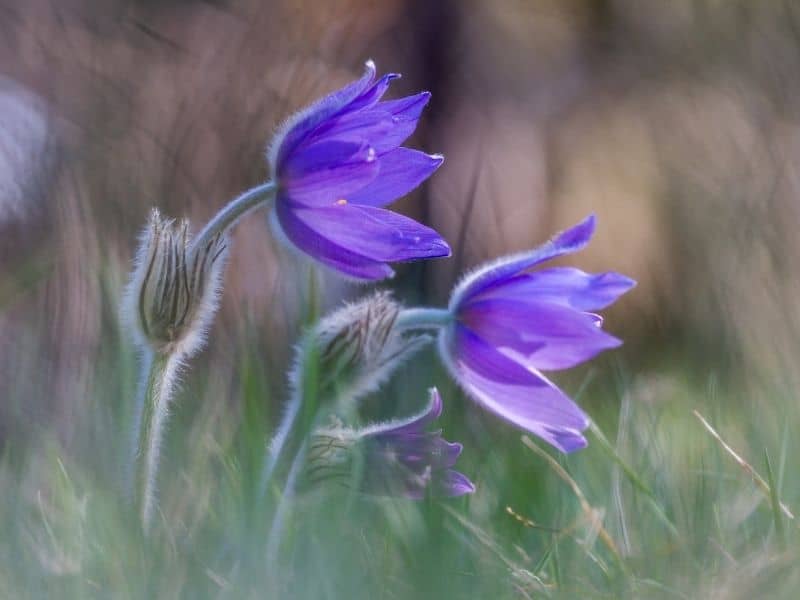
In 1903, South Dakota chose the American pasque flower as its state flower. This native prairie plant is among the first flowers to bloom in the spring, often with snow still on the ground. Its small, crocus-like blossoms have five to seven purple sepals, but no true petals, surrounding a cluster of bushy yellow stamens. The flowers give way to pom-pom seed heads, and the plant’s silvery, feathery foliage provides interest throughout the summer.
Pasque flower thrives in well-draining soil in full to part sun, and it grows best with a prolonged winter chill.
Tennessee state flower – iris (Iris sp.)
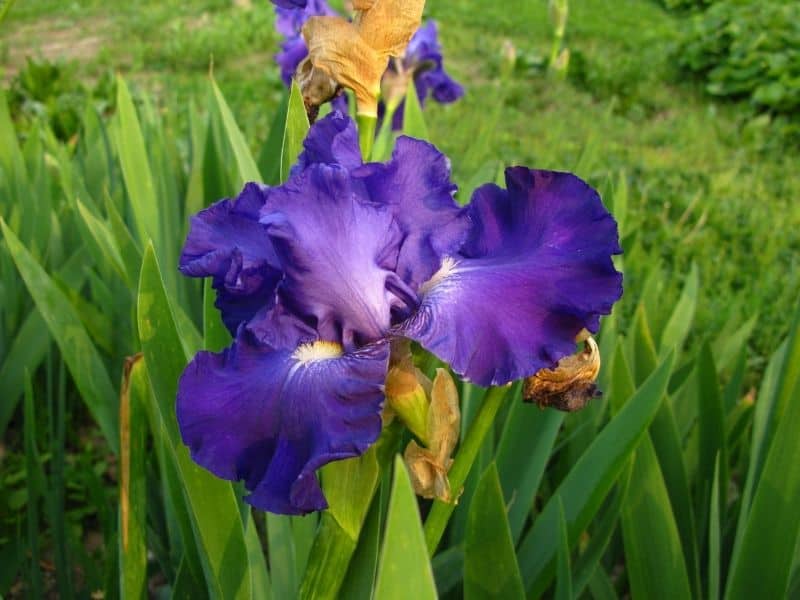
Tennessee designated iris as a state flower in 1933, in addition to passion flower. Legislation has since distinguished iris as the state cultivated flower and passion flower (as well as Tennessee coneflower) as the state wildflower. Although the legislation did not specify a particular cultivar, purple iris is commonly considered the state flower. Iris blooms in spring, summer, or fall depending on the variety and features three drooping and three upright petals.
All irises require at least six to eight hours of direct sunlight each day, but soil requirements vary by cultivar.
Texas state flower – bluebonnet (Lupinus sp.)
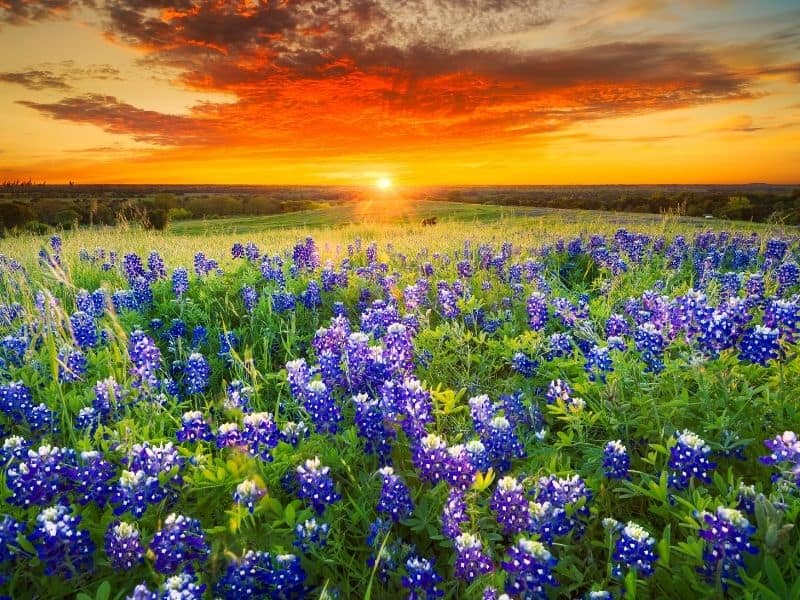
In 1901, Texas chose the bluebonnet as its state flower. Although the legislation named L. subcarnosus, commonly called Sandyland bluebonnet or Texas bluebonnet, it was amended 70 years later to include all bluebonnets.
These native prairie flowers can be seen blooming throughout Texas from March through May, sending up spikes of blue, sunbonnet-shaped blossoms. They can sometimes be found in other colors too.
Bluebonnets thrive in dry, fast-draining soil and full sun. In ideal conditions, these annuals will self-seed.
Utah state flower – sego lily (Calochortus nuttalli)
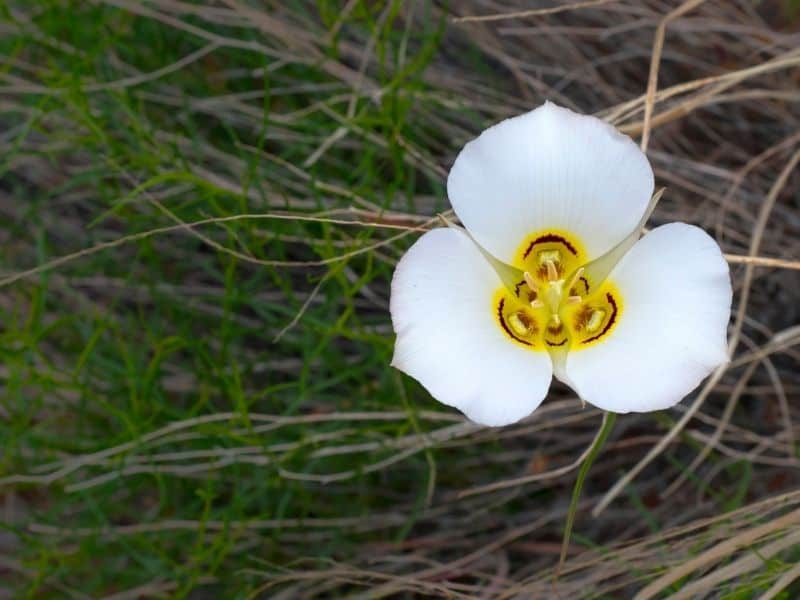
Sego lily was selected as the Utah state flower in 1911. In early summer, each bulb of this perennial wildflower produces one to three large blossoms featuring three white to blue petals and three narrow sepals in an upright cup shape. The grass-like, gray-green leaves grow about 10 to 20 inches tall and six to nine inches wide before withering later in the season.
Sego lily grows best in sandy or loamy, dry soil, and full sun, and it will tolerate drought extremely well.
Vermont state flower – red clover (Trifolium pratense)
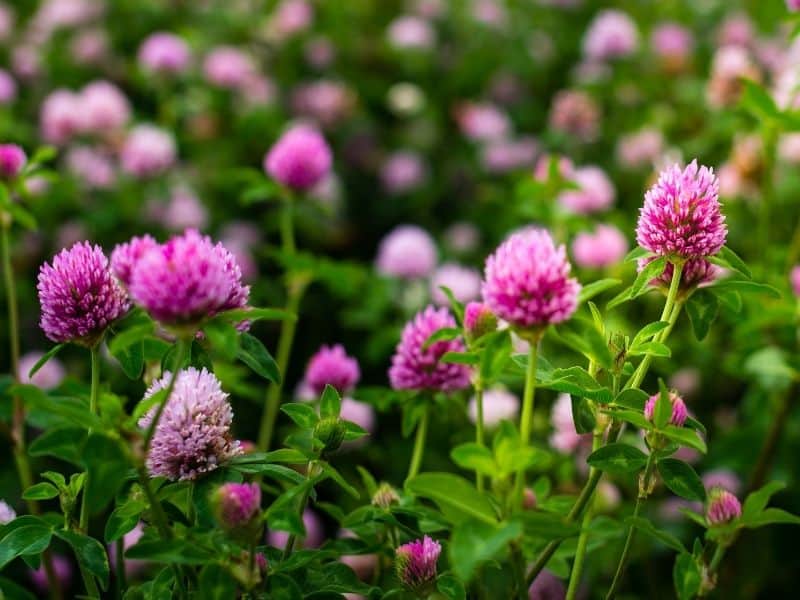
In 1894, Vermont named red clover as its state flower. This common wildflower is most often grown as a cover crop or forage plant. In addition to the characteristic three-leafed foliage, it produces purple-red pom-pom blossoms that attract bees and other pollinators.
Red clover tolerates drought and poor soil but prefers moderately fertile, slightly acidic to neutral soil and partial shade.
Virginia state flower – American dogwood (Cornus florida)
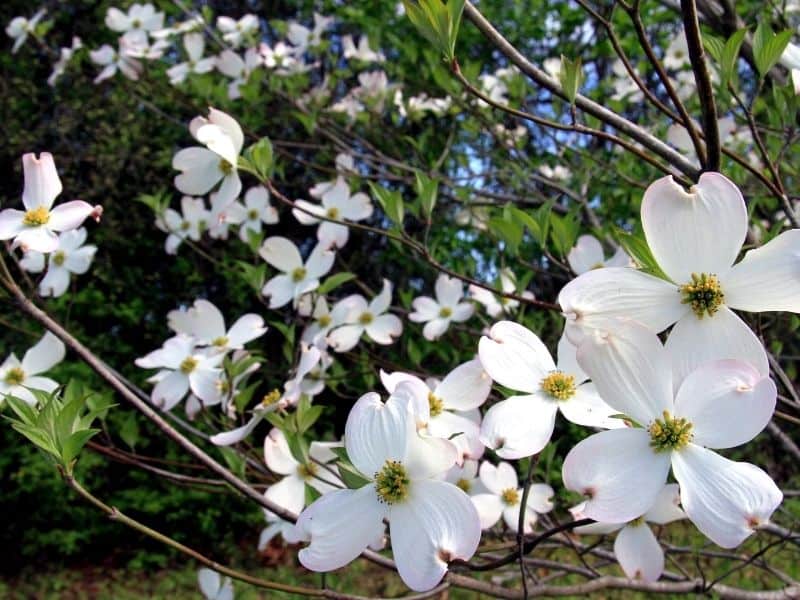
Virginia selected American dogwood as its official state flower in 1918, more than 20 years before North Carolina chose the same flower. It was also named the state tree. This small native tree blooms in the spring, creating a showy display of white to pink, four-petaled flowers.
American dogwood thrives in partial shade and rich, moist, slightly acidic, well-draining soil.
Washington state flower – coast rhododendron (Rhododendron macrophyllum)
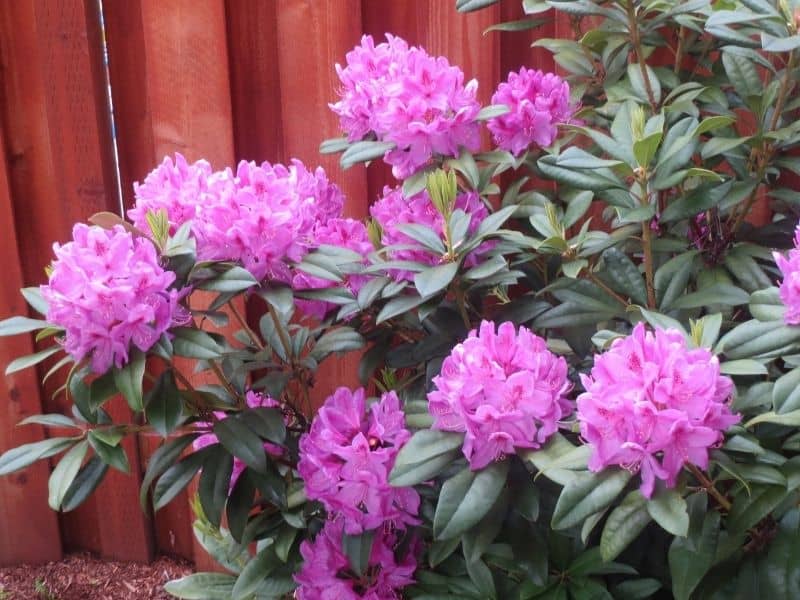
Although chosen as the Washington state flower in 1892 for the World’s Fair, coast rhododendron was not officially designated until 1959. Also called Pacific or big leaf rhododendron, coast rhododendron is an evergreen shrub native to western North America. It blooms from late spring through early summer, typically in shades of pink.
Coast rhododendron grows surprisingly well in disturbed areas and is easy to care for, requiring only well-draining soil and partial sun.
West Virginia state flower – rhododendron (Rhododendron maximum)
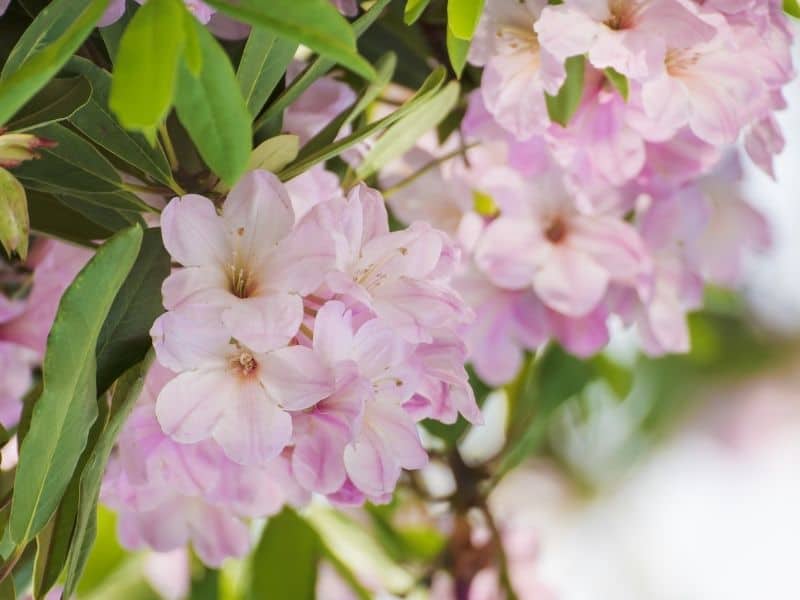
Rhododendron was named the West Virginia state flower in 1903. Native to eastern North America, the great rhododendron, or great laurel, blooms in late spring, much like its western counterpart (R. macrophyllum). The funnel-shaped flowers have five lobes and range from white to rose red, though pale shades are more common.
Great rhododendron prefers moist, humus-rich, acidic, well-draining soil and partial shade, though it will tolerate full shade.
Wisconsin state flower – wood violet (Viola sororia)
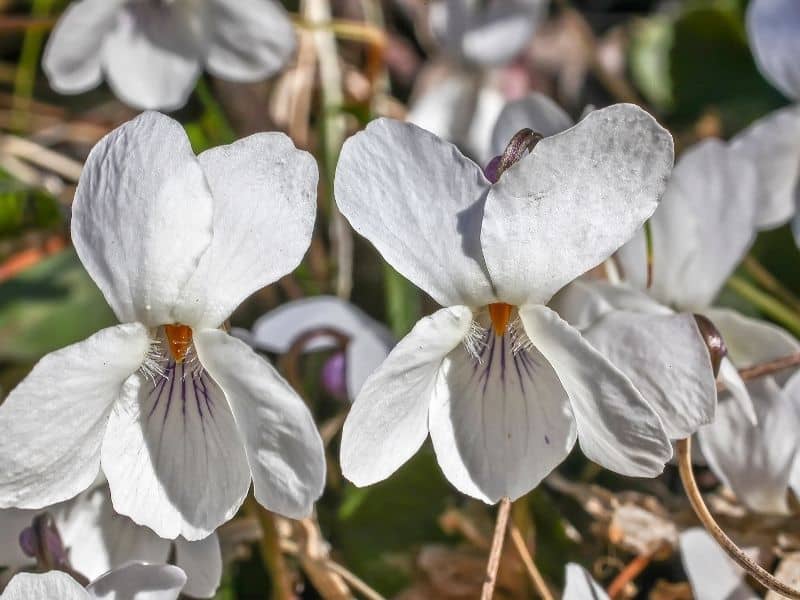
Wisconsin adopted the wood violet as its state flower on Arbor Day in 1909. Also called common blue violet, wood violet can often be found growing wild in thickets and woods and along shady streambeds. Its early spring blossoms, ranging from white to purple, attract bees and butterflies.
Wood violets require very little care, growing and reseeding happily when provided with rich, moist, well-draining soil and partial shade.
Wyoming state flower – Indian paintbrush (Castilleja linariifolia)
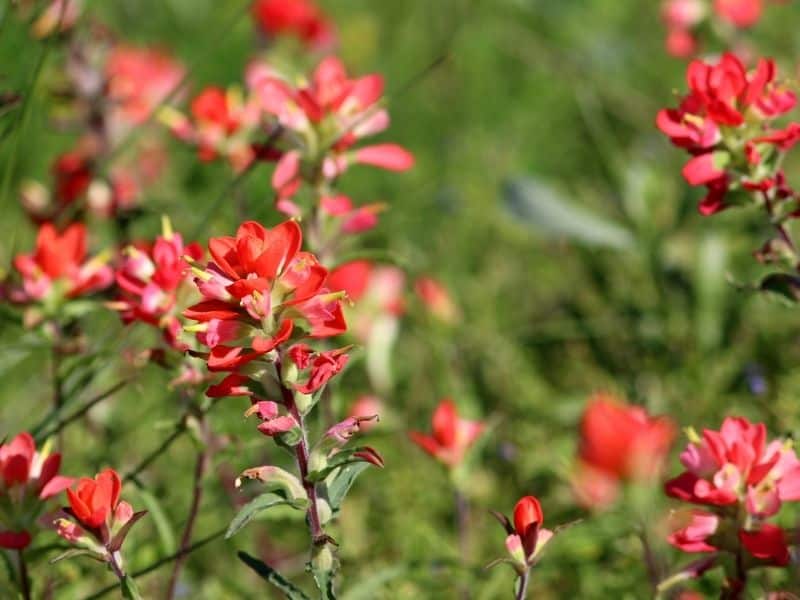
Indian paintbrush was chosen as the Wyoming state flower in 1917. This native wildflower grows on arid plains, rocky slopes, and pinyon pine or juniper woodlands throughout the western U.S. Also fittingly called Wyoming paintbrush, it grows two to four feet tall and features very narrow leaves and red, brushlike flowers.
Indian paintbrush grows best in full to part sun and sandy, well-draining soil. It requires little to no supplemental water once established.
Official flowers of U.S. territories
Washington, D.C., snuck its way onto the state flower list, but the U.S. territories, though also not technically states, also have official flowers! Here’s a quick overview:
- American Samoa: paogo (Pandanus tectorius)
- Guam: bougainvillea (Bougainvillea spectabilis)
- Northern Mariana Islands: plumeria (Plumeria rubra)
- Puerto Rico: flor de maga (Thespesia grandiflora)
- Virgin Islands: yellow elder (Tecoma stans)
Such a wonderful variety of flowers represents the U.S. and its territories! I hope you have learned a bit about this beautiful country and perhaps gained some inspiration for your own little piece of it.
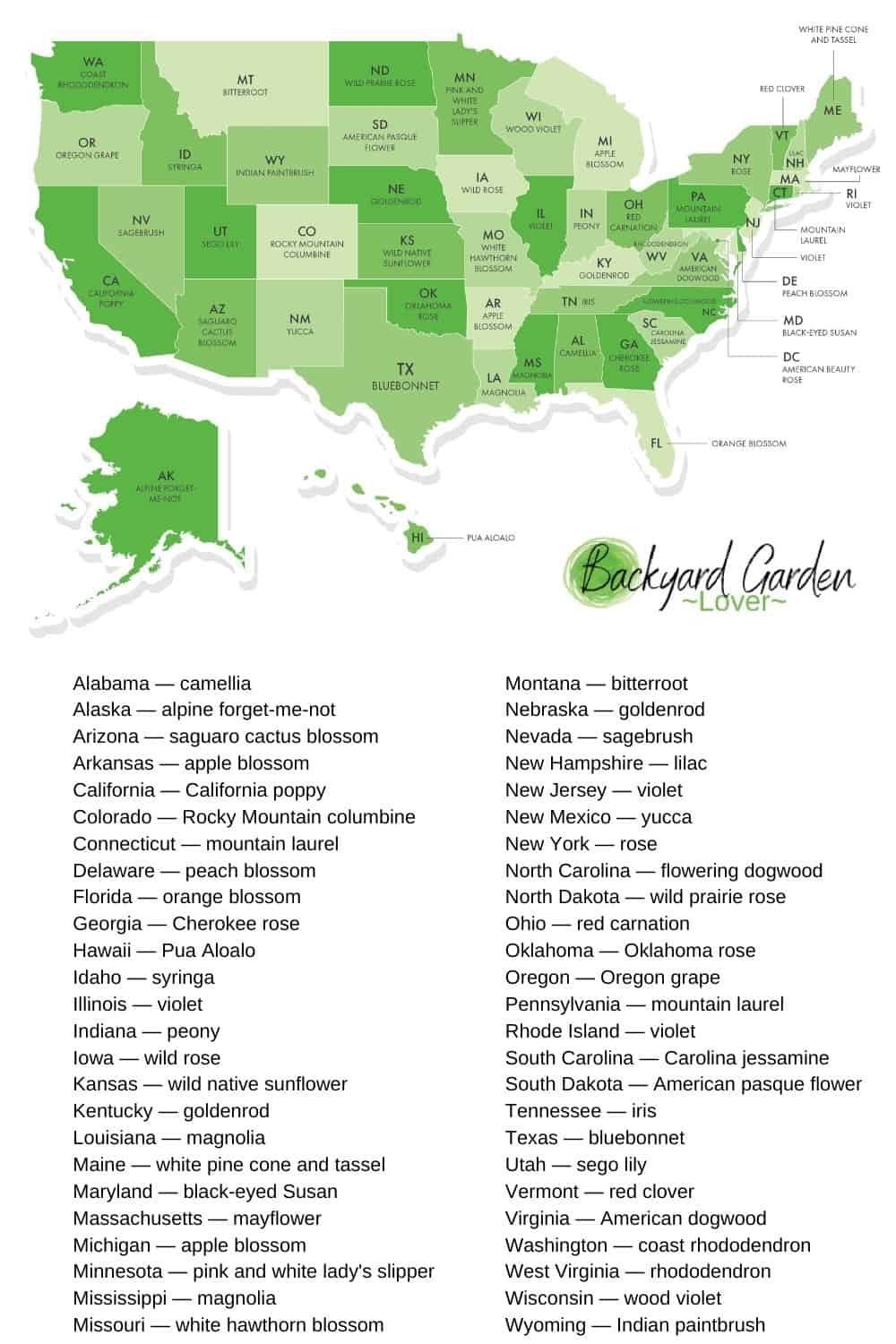

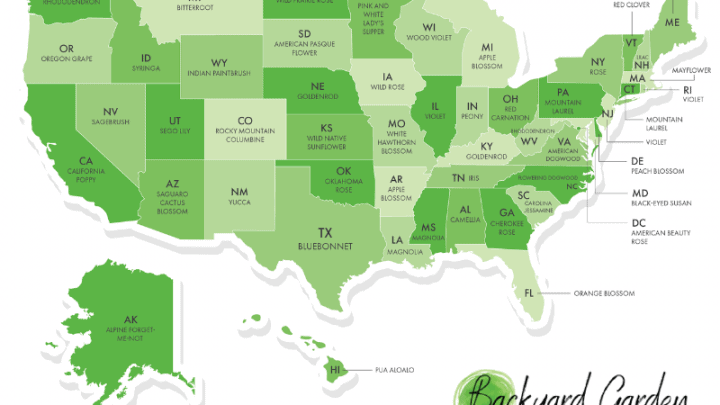

Hawaii Native Plants List: 7 Stunning Plants From The Aloha State
Wednesday 18th of January 2023
[…] and blooms yellow-colored flowers. These flowers can grow from 4 to 6 inches wide. It’s the official state flower for Hawaii and it grows in dry forests and shrublands in lower elevations. As the state flower, it […]
Kansas Native Plants List: 11 Best Wildflowers To Brighten Your Lawn
Monday 6th of September 2021
[…] Sunflowers are native to Kansas. In fact, they are so well known to Kansas that they are the official state flower. […]
Arizona Native Plants List: 10 Of The Grand Canyon State's Most Remarkable Floral Representatives
Sunday 25th of July 2021
[…] Saguaros provide a spectacular addition to native xeric gardenscapes, requiring only a well-drained, sun-drenched spot to flourish. Occasionally maturing as a single column, they more typically branch upon reaching 10 or 15 feet in height. They sport their white blooms – Arizona’s state flower – in late spring. See a state flowers list here. […]
Florida Native Plants List - 10 Flowers That Bloom With Beauty
Sunday 4th of July 2021
[…] orange blossom is the flower of the orange tree. It is Florida’s state flower (see all state flowers here) and is one of the most fragrant flowers in the entire […]